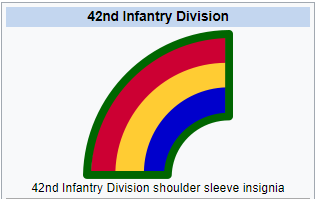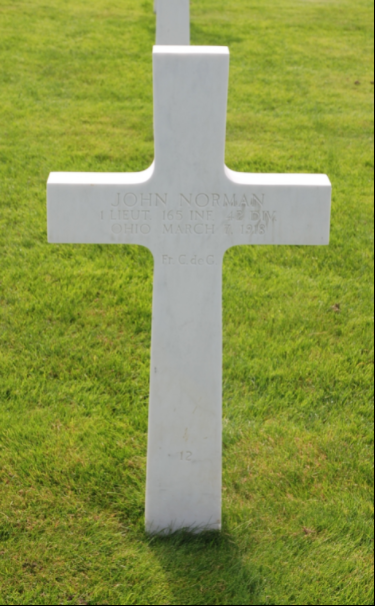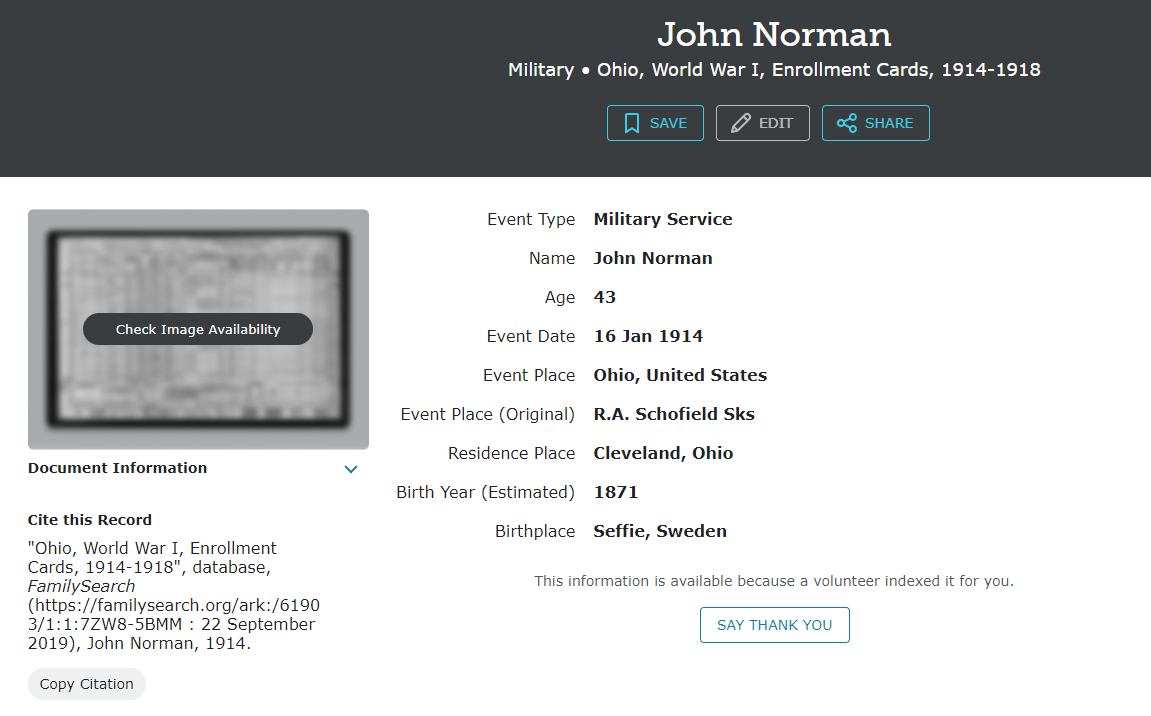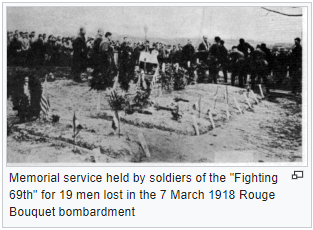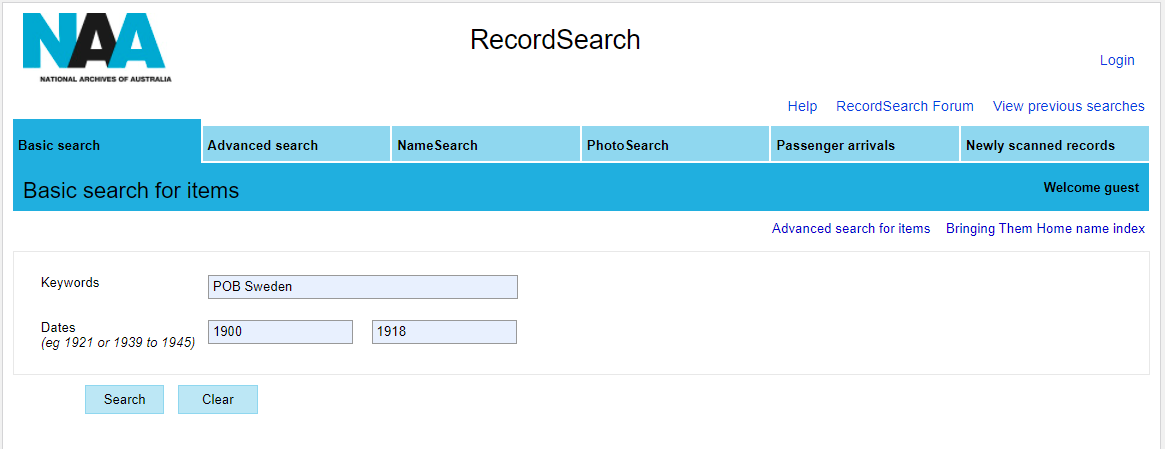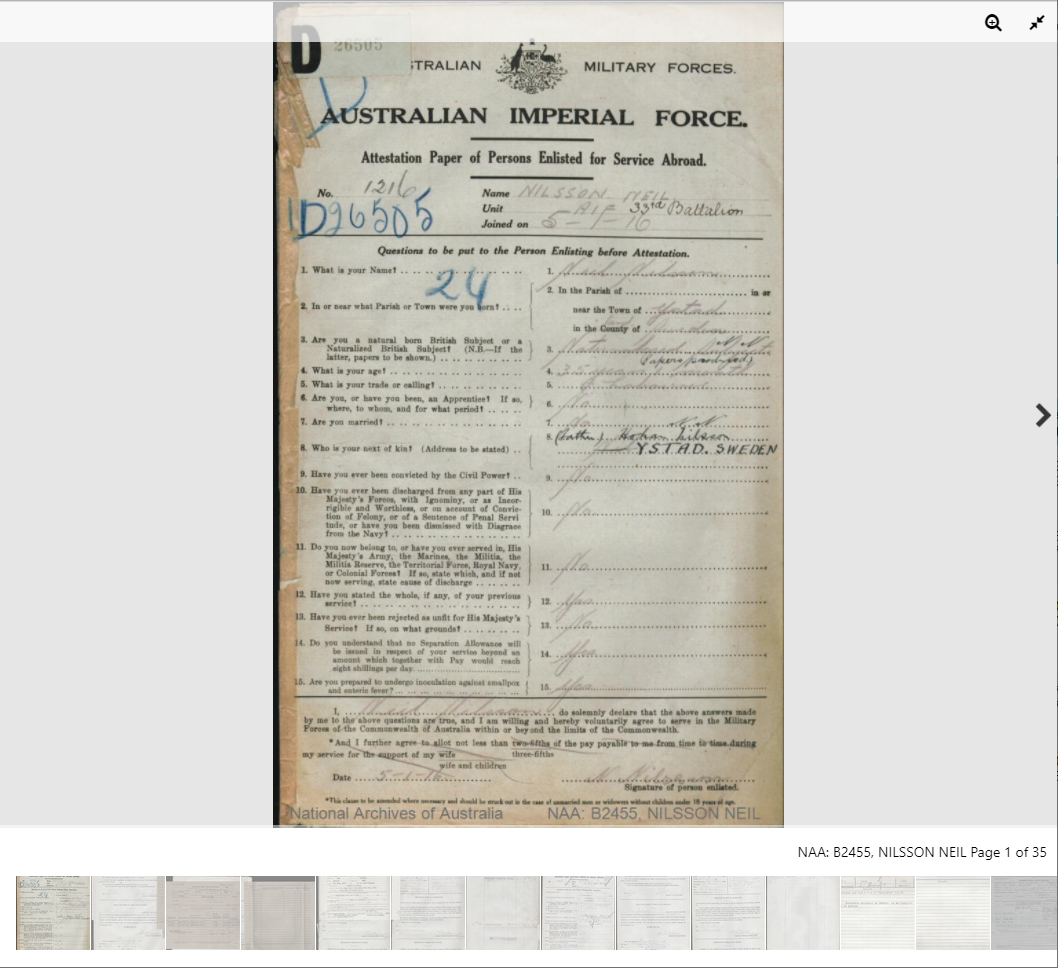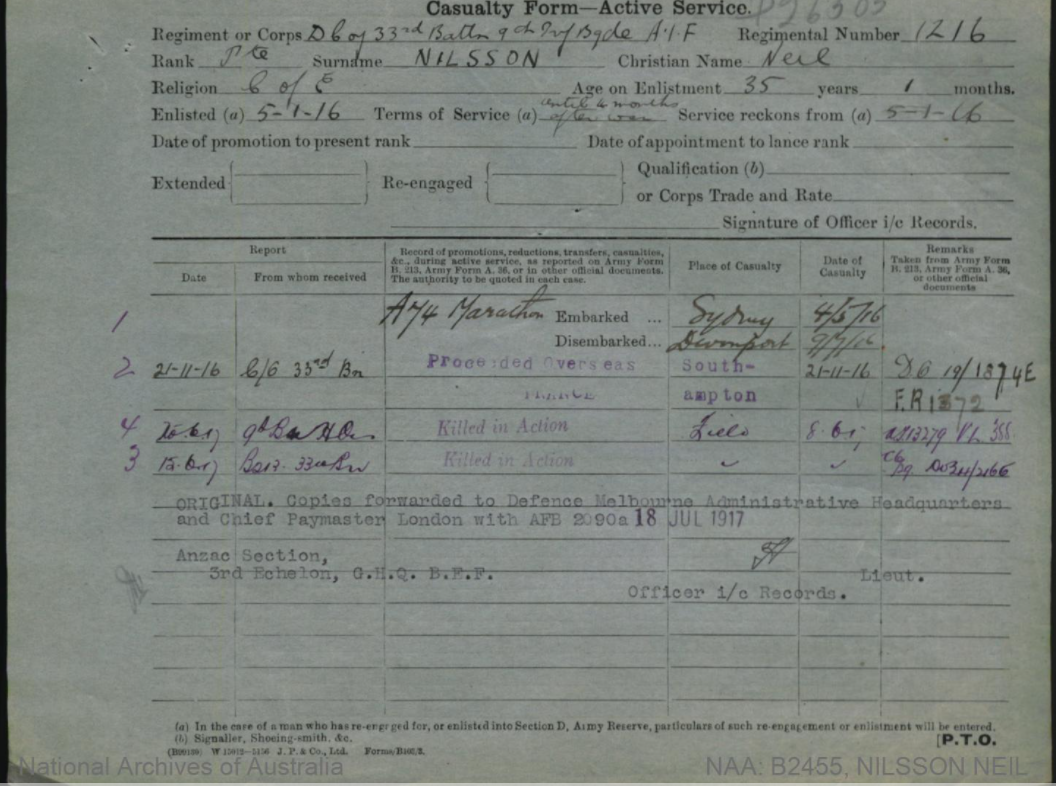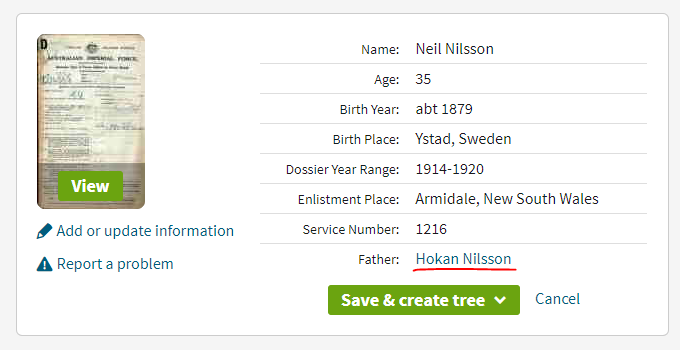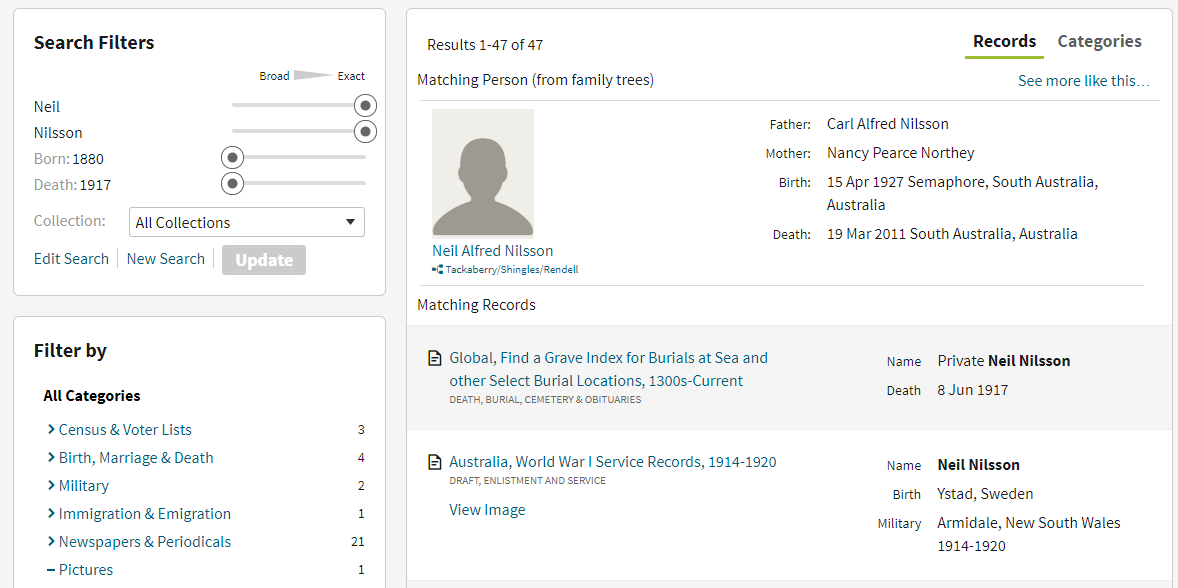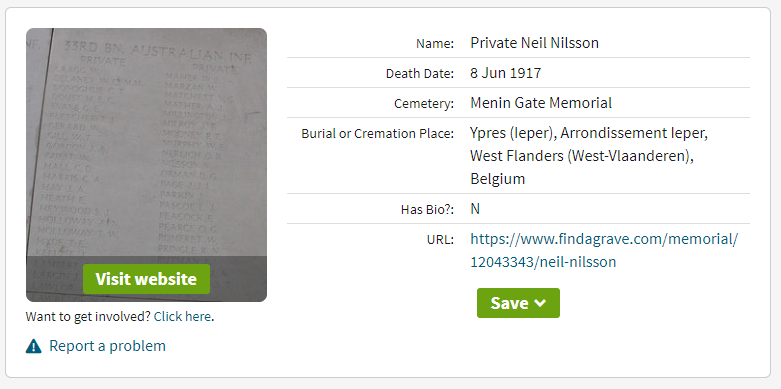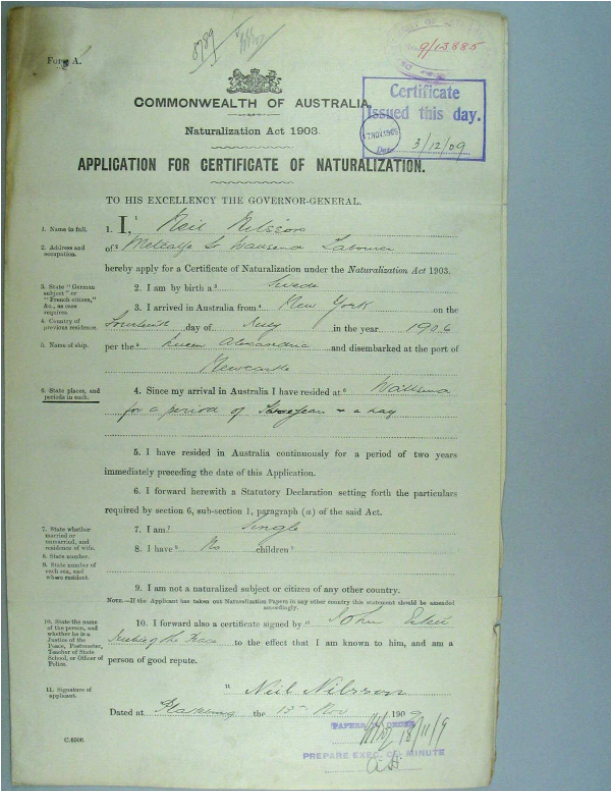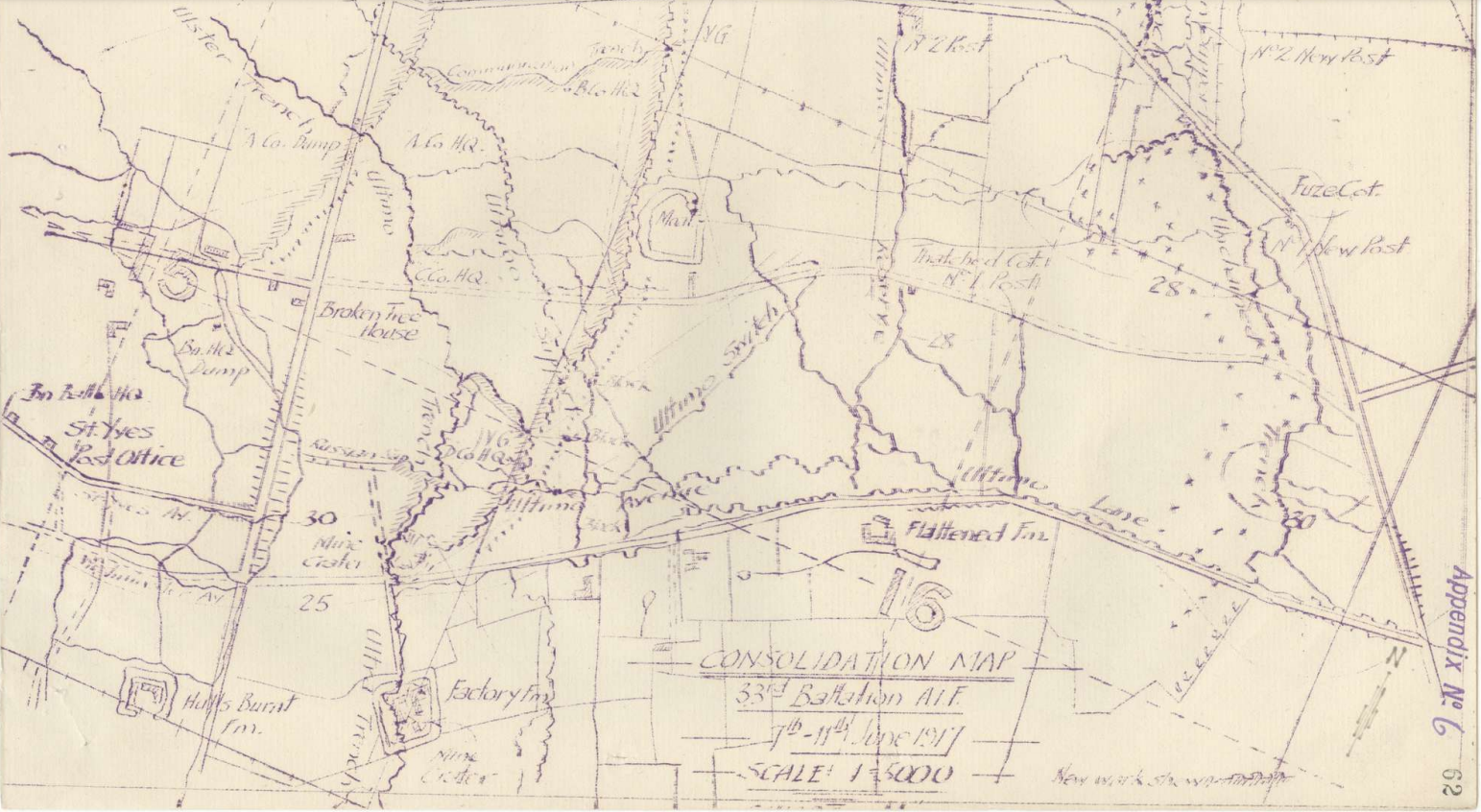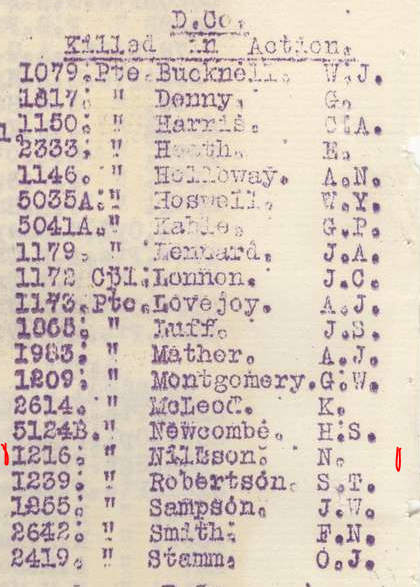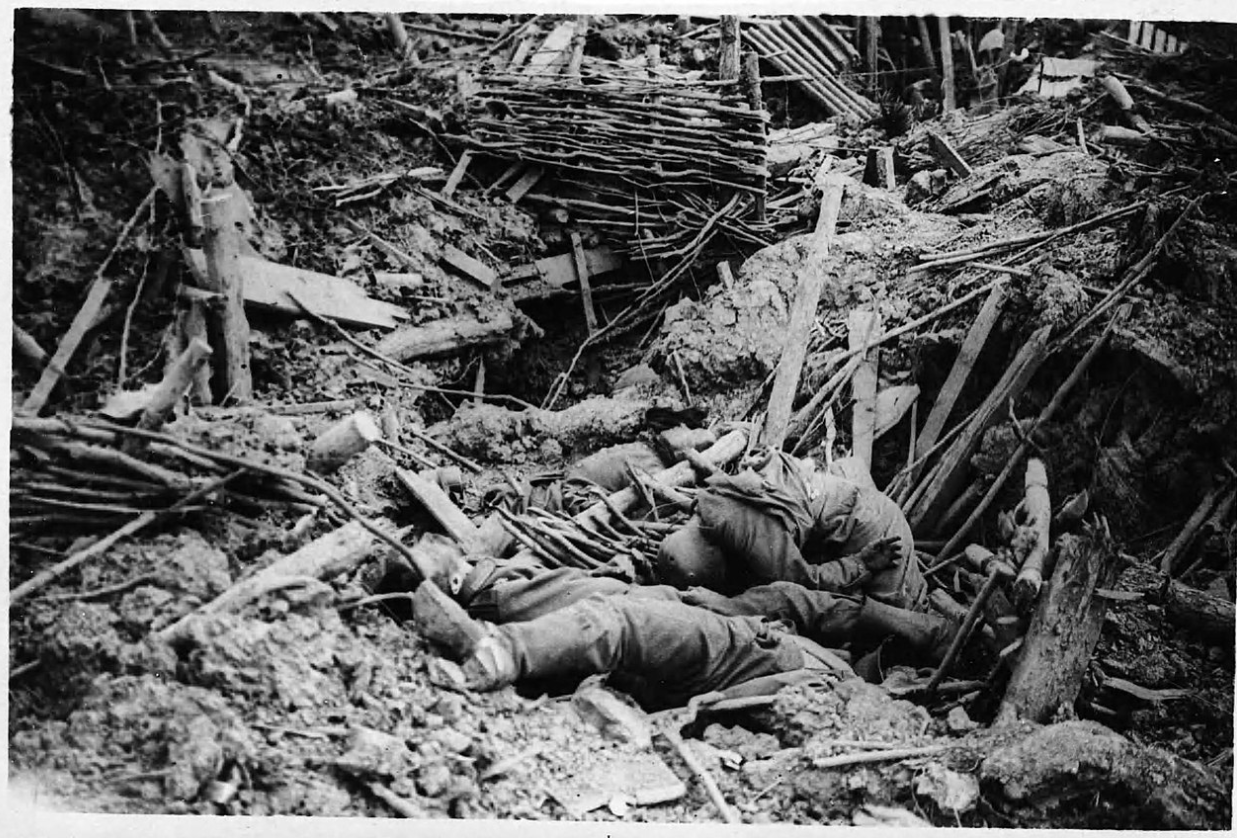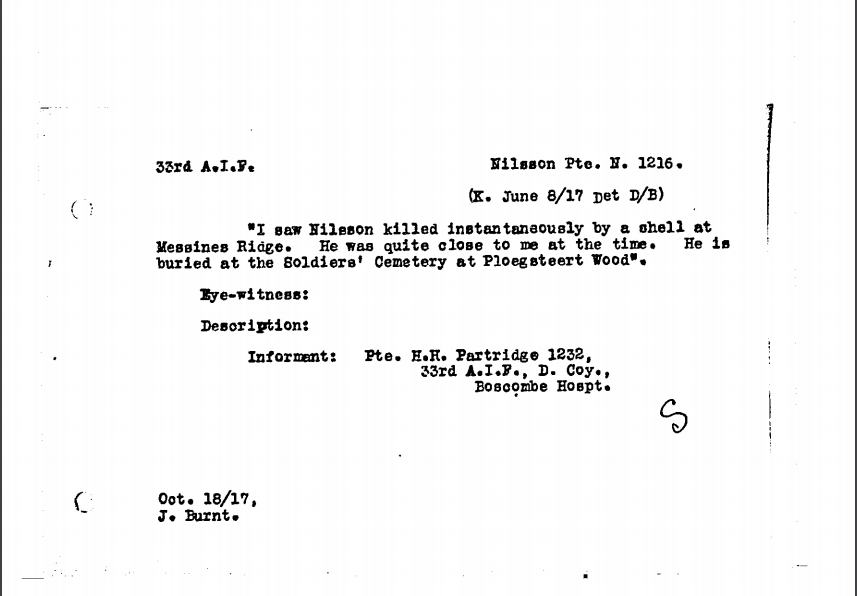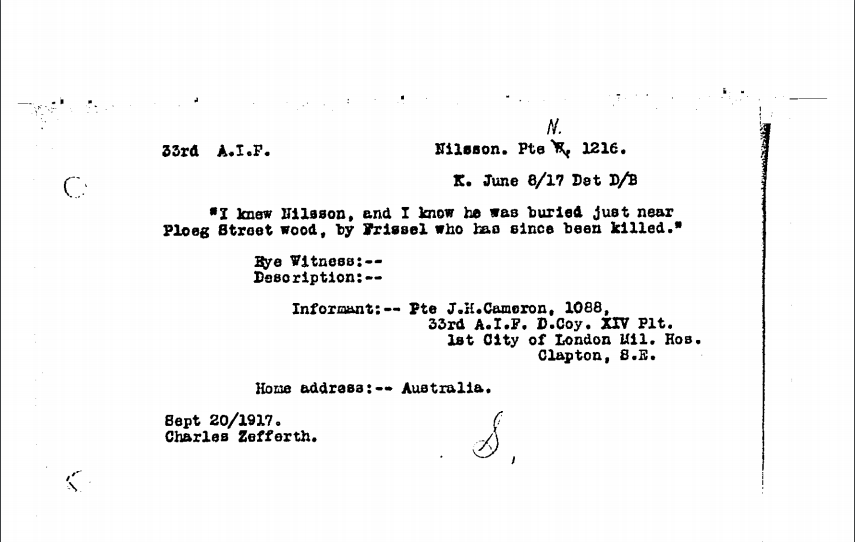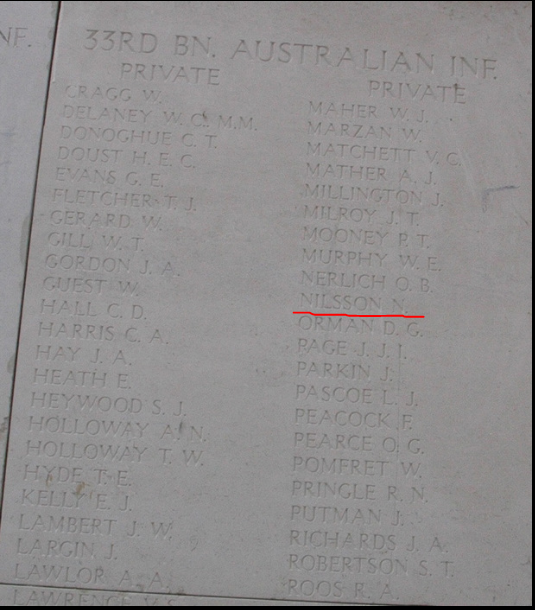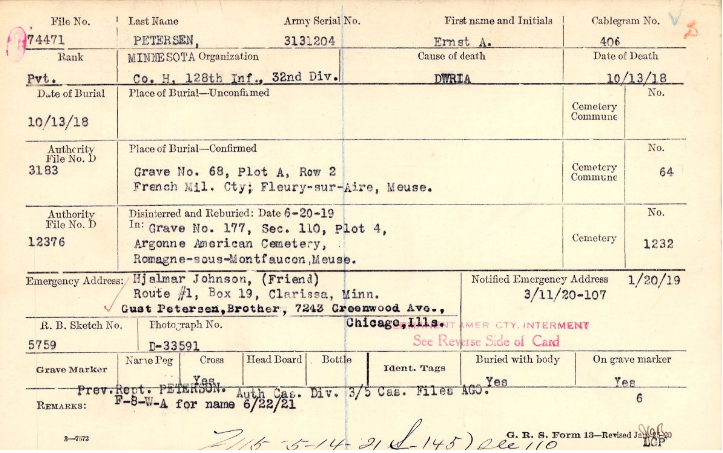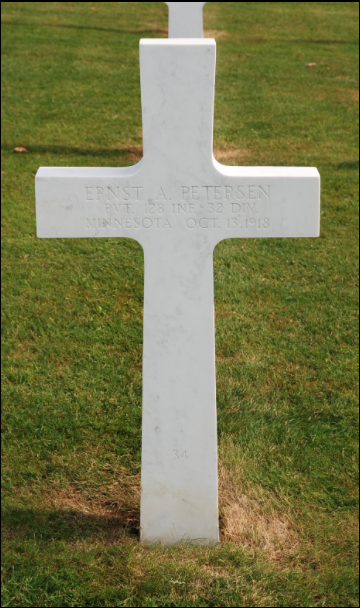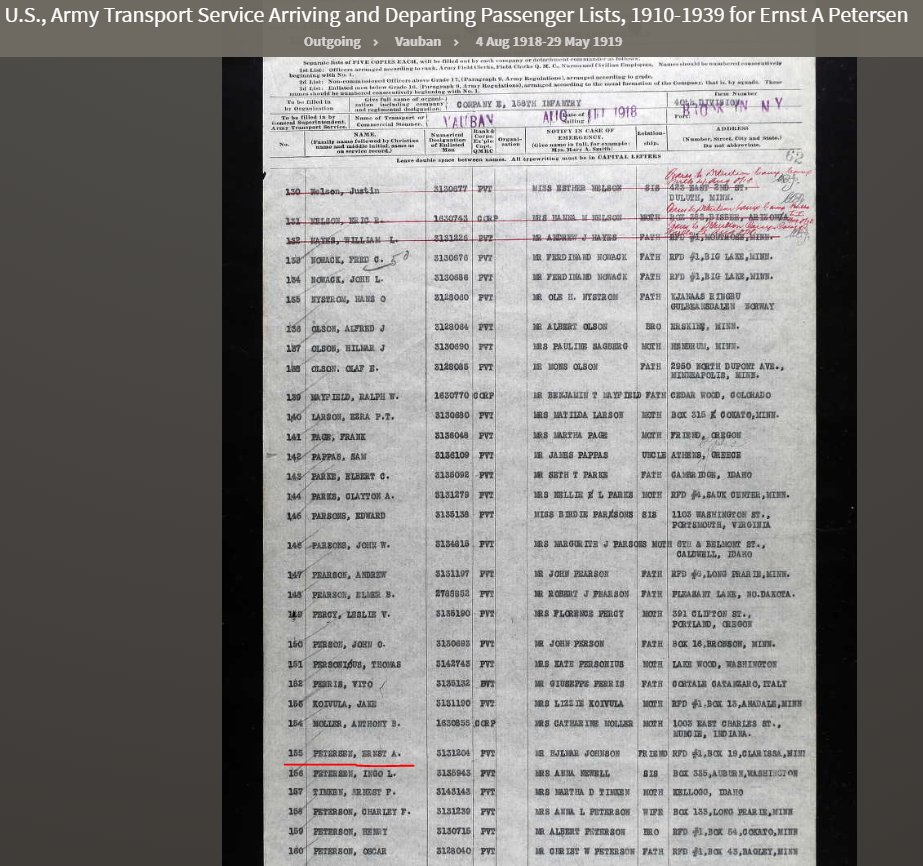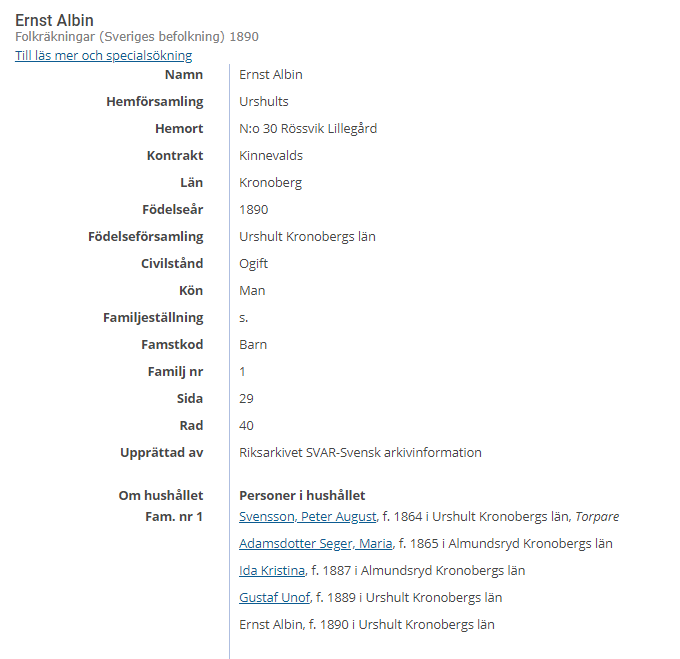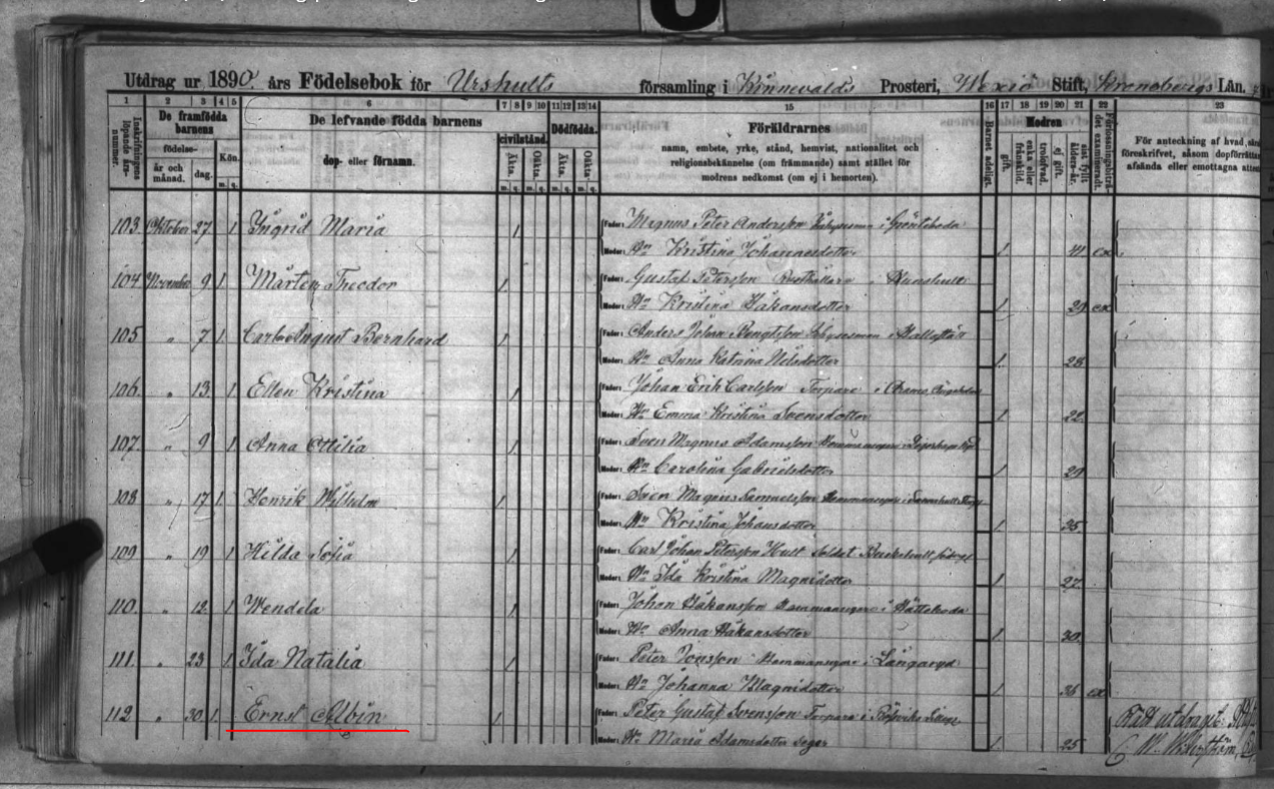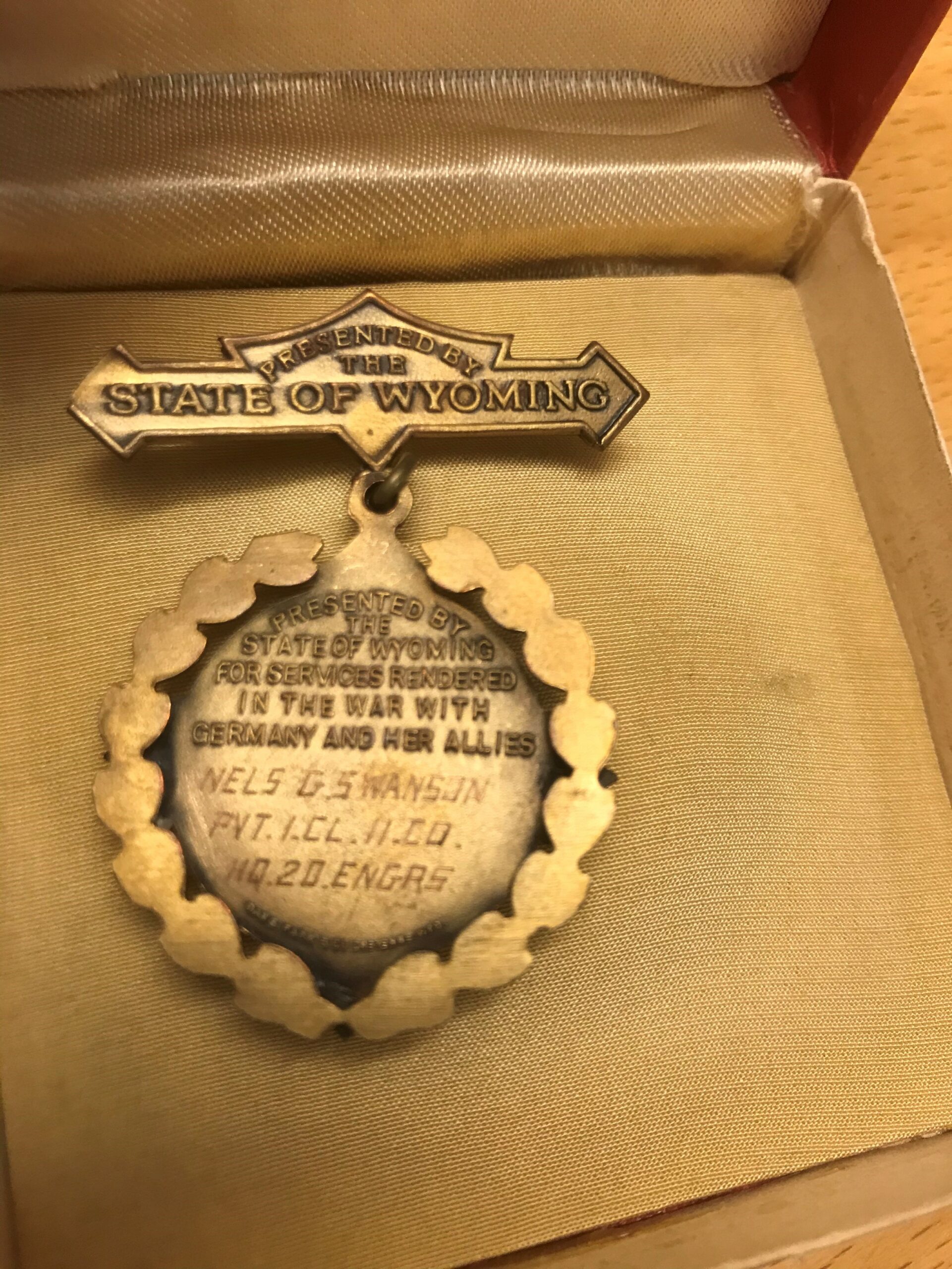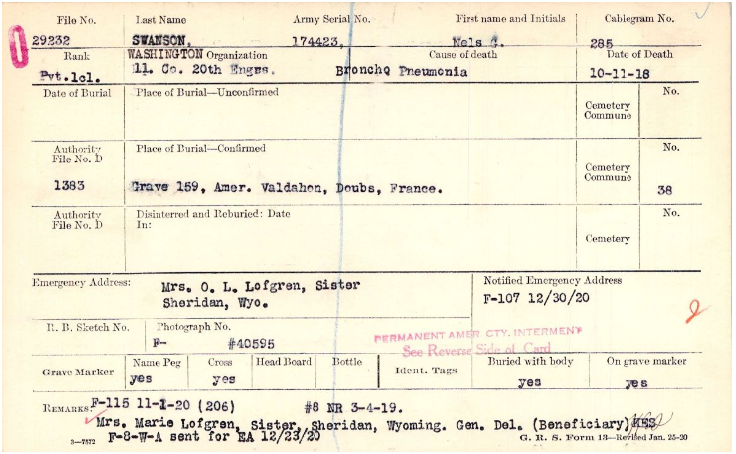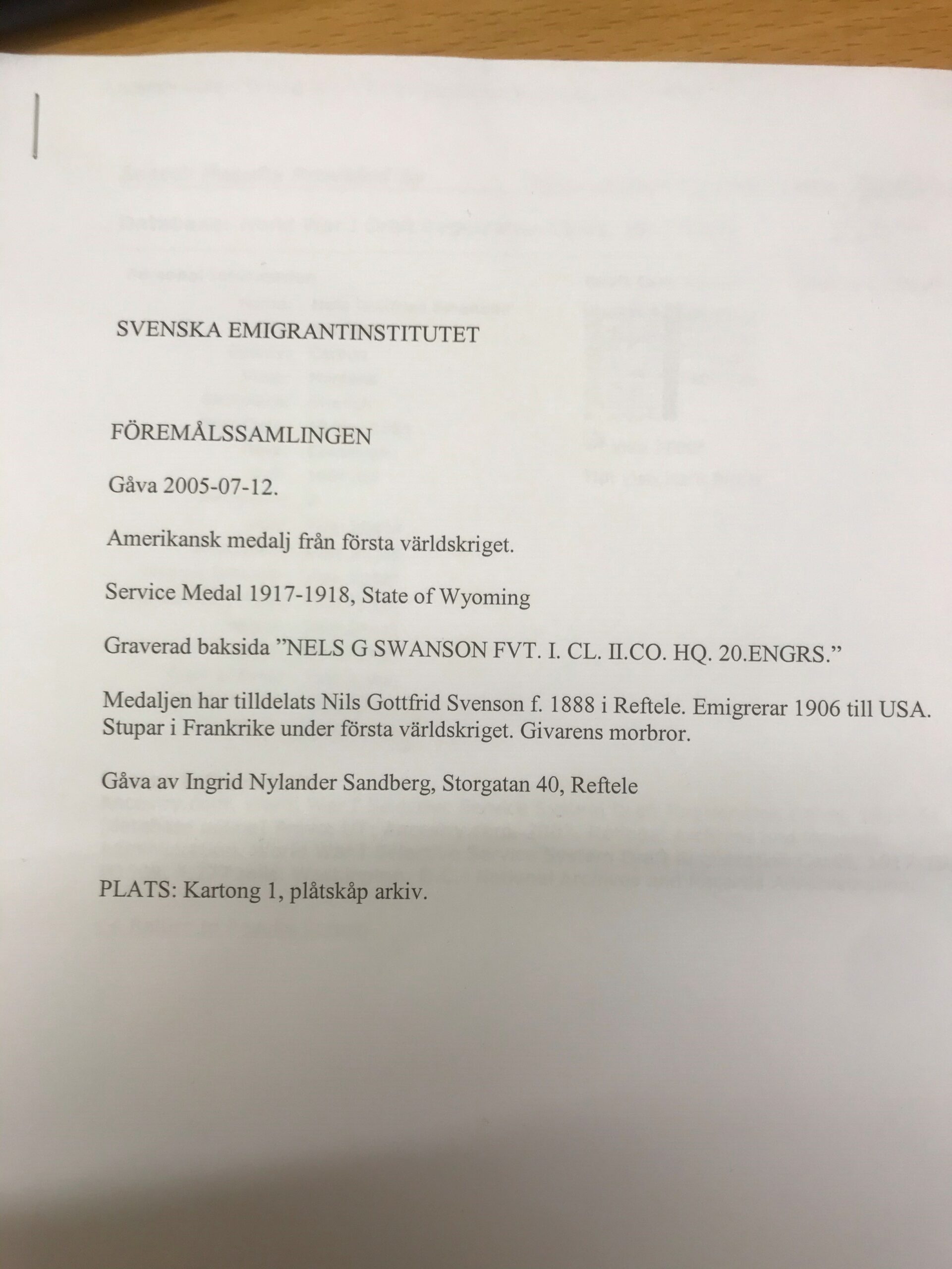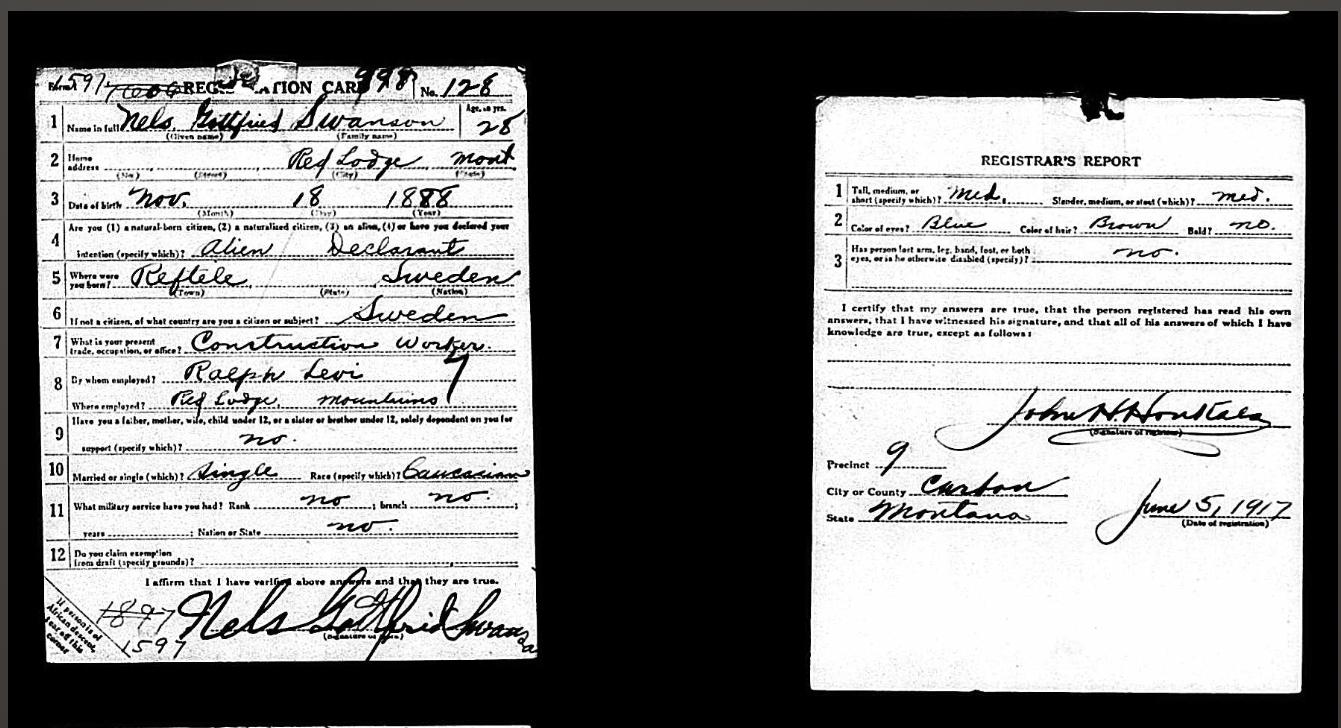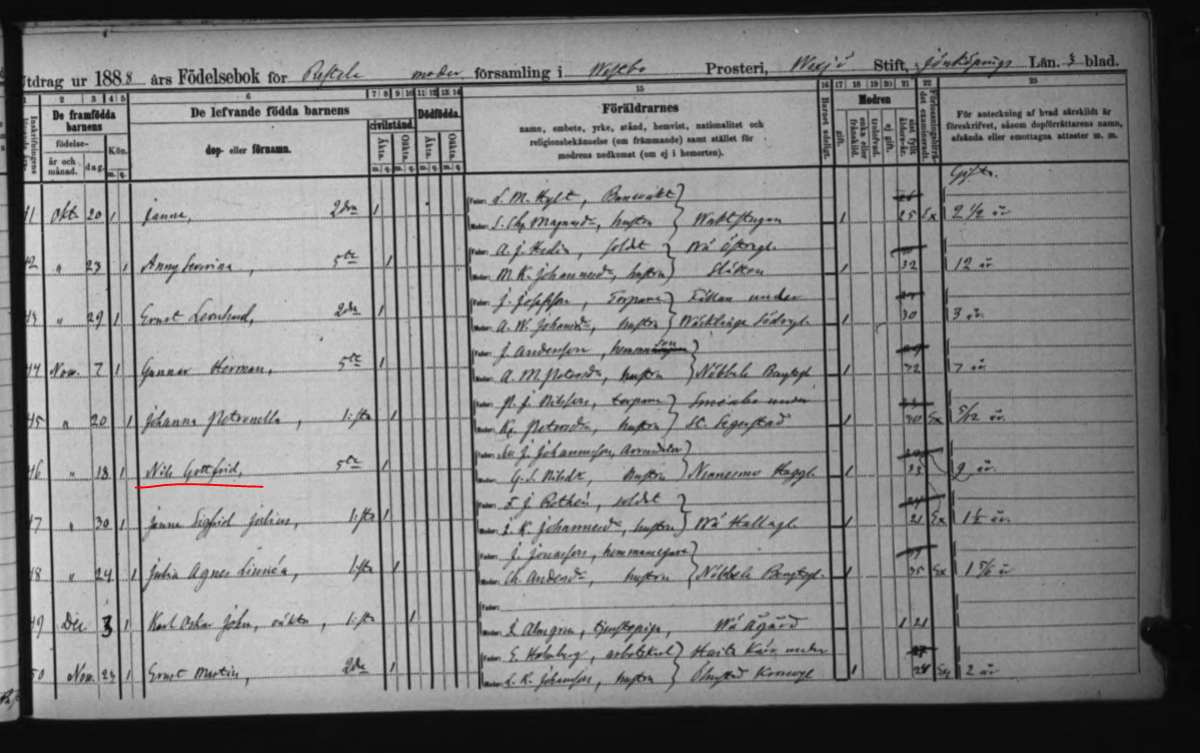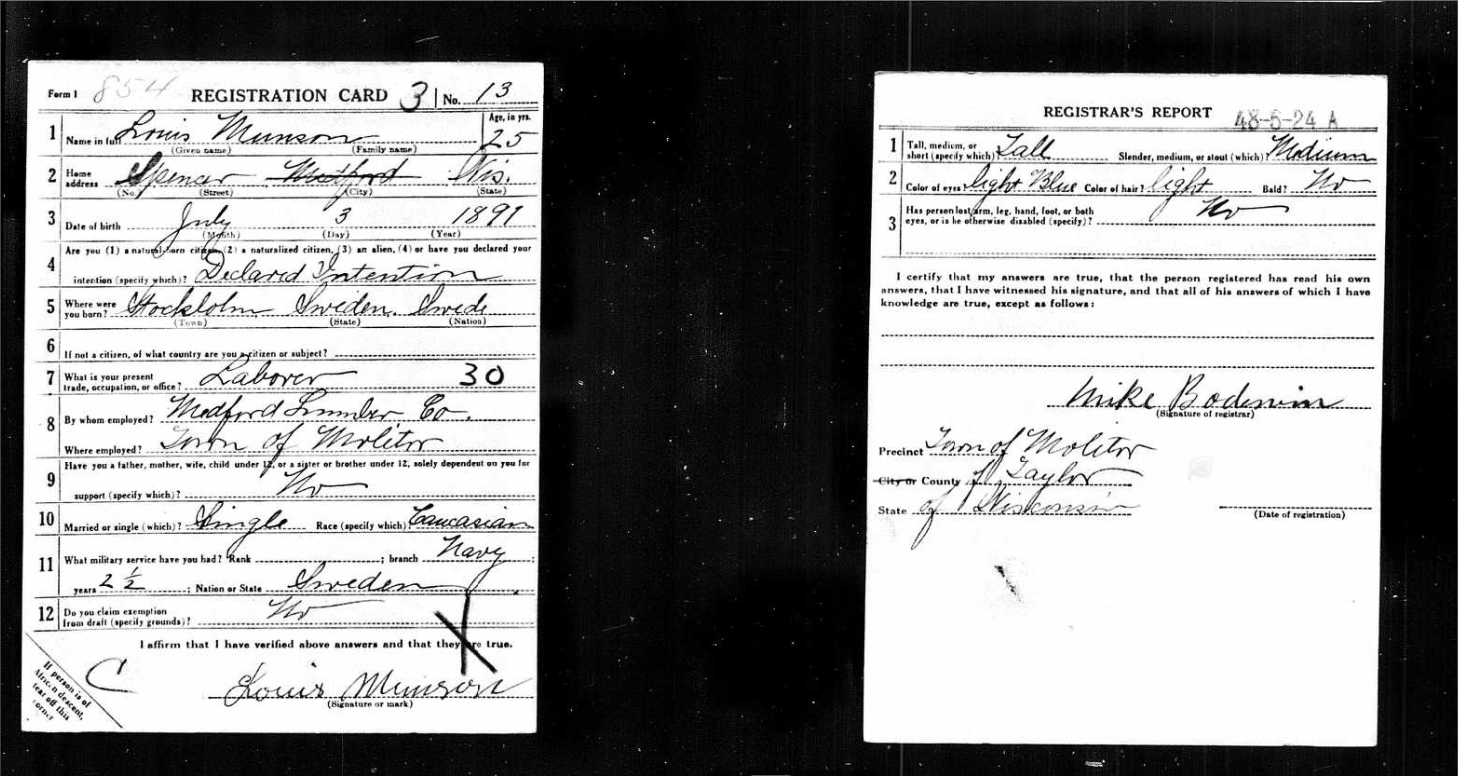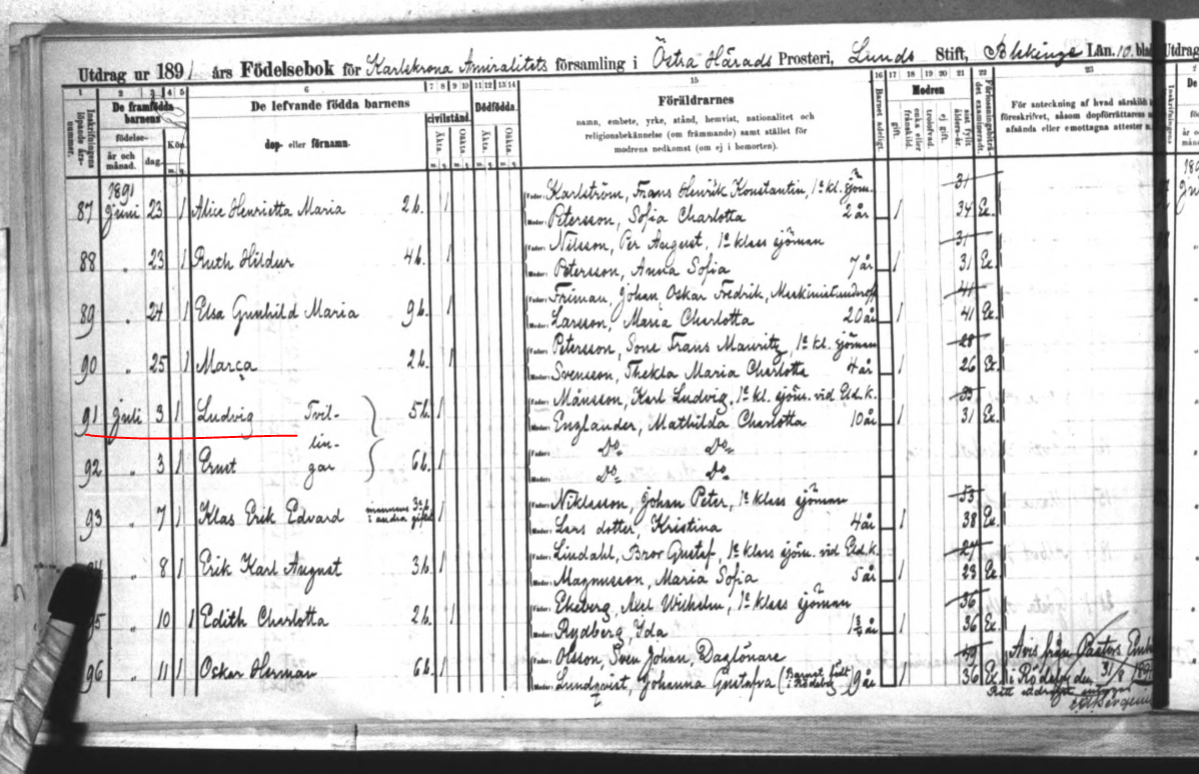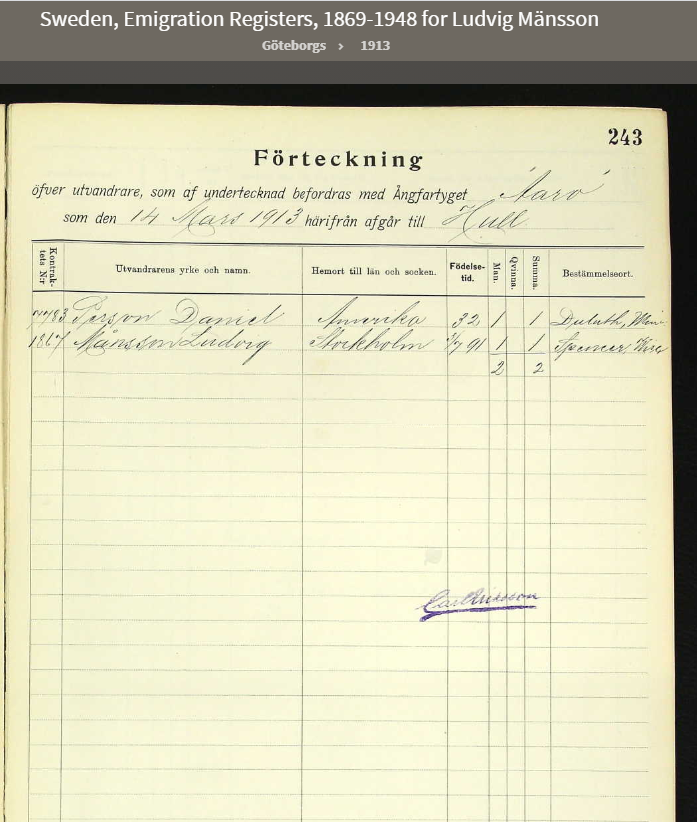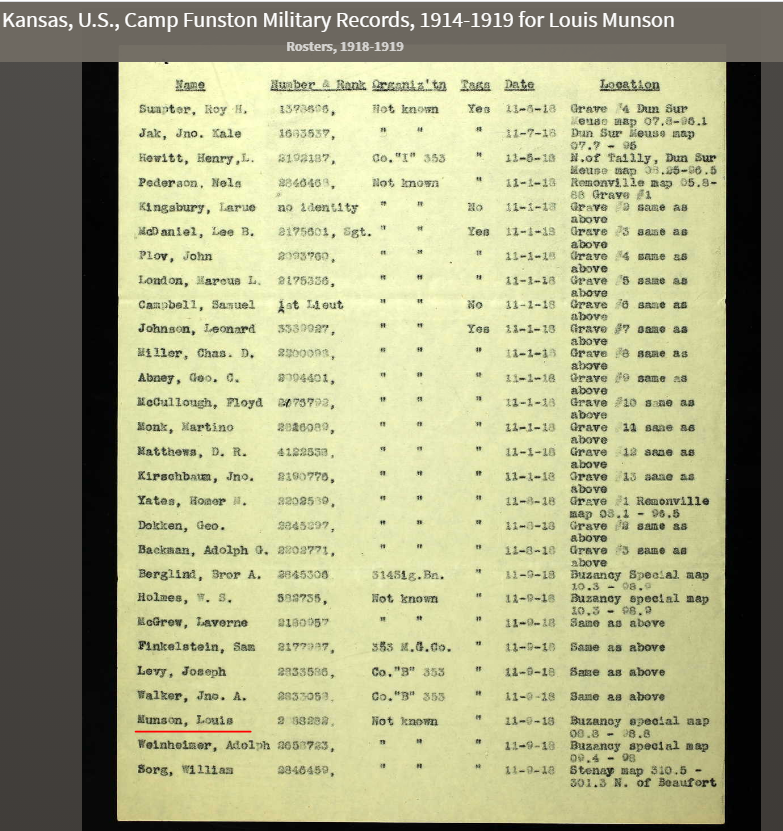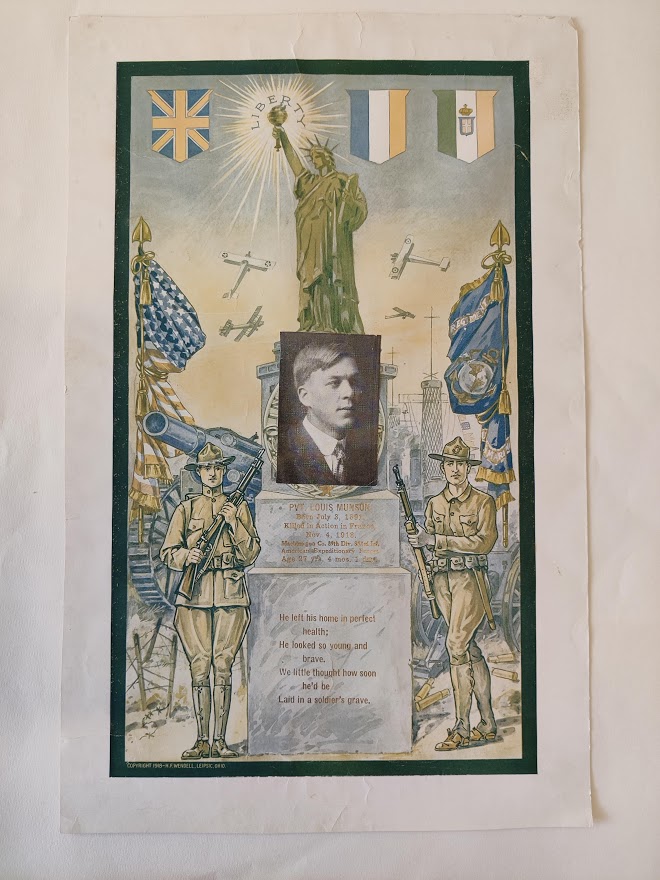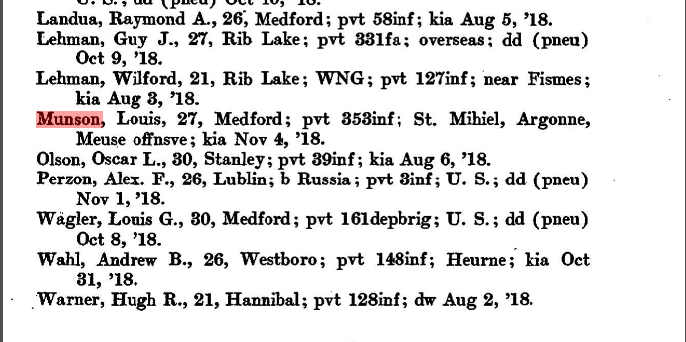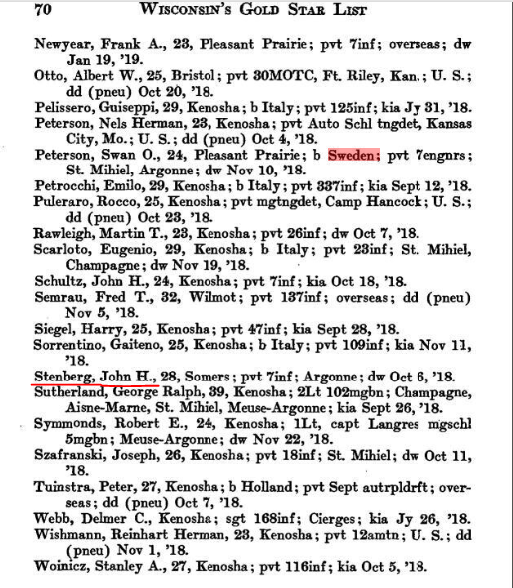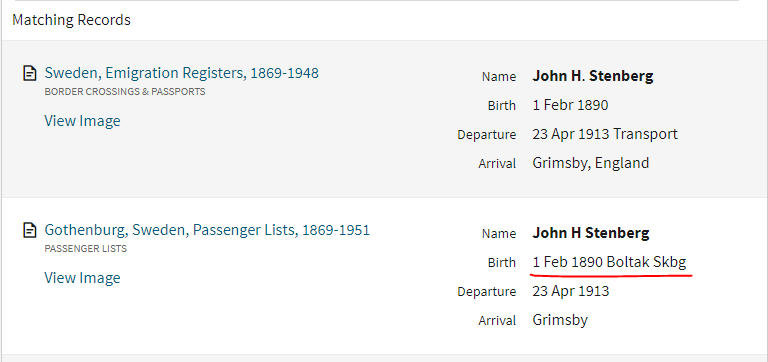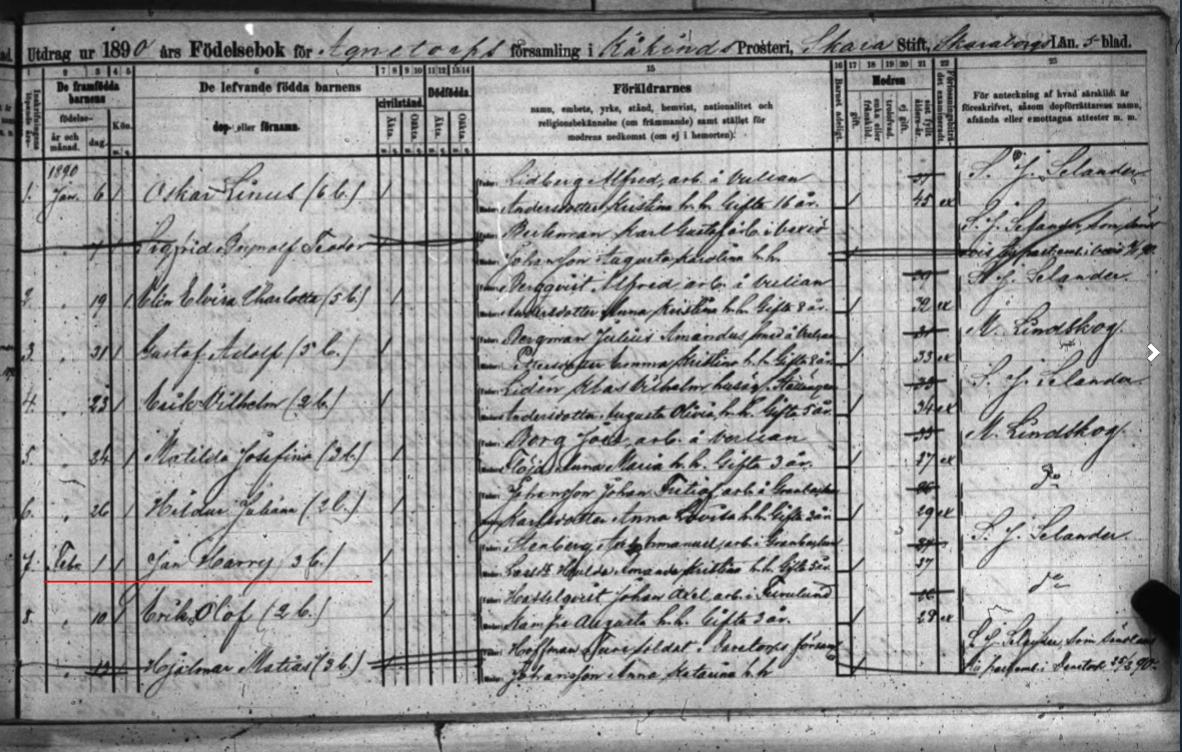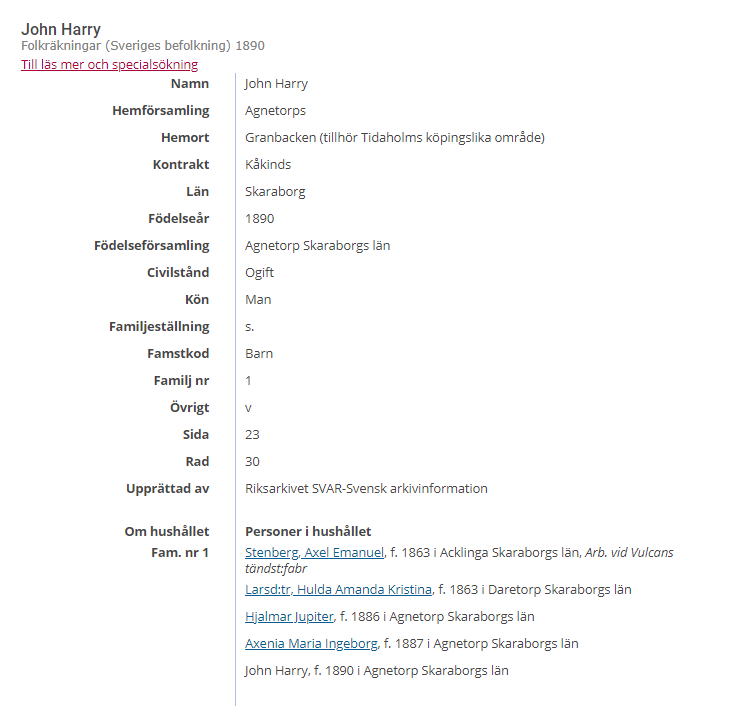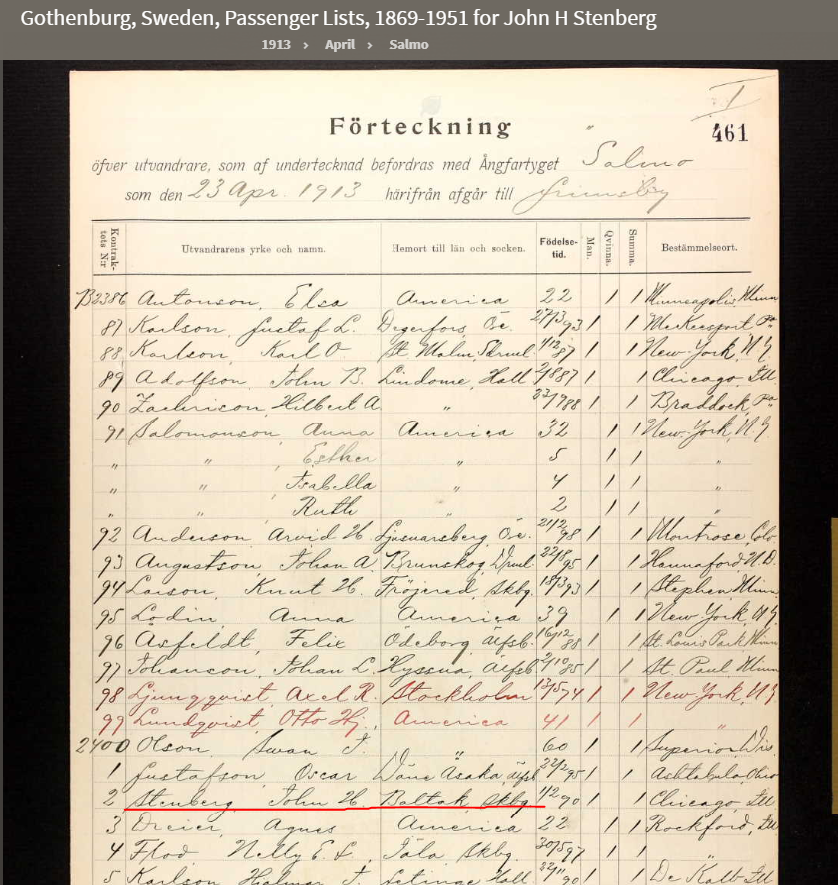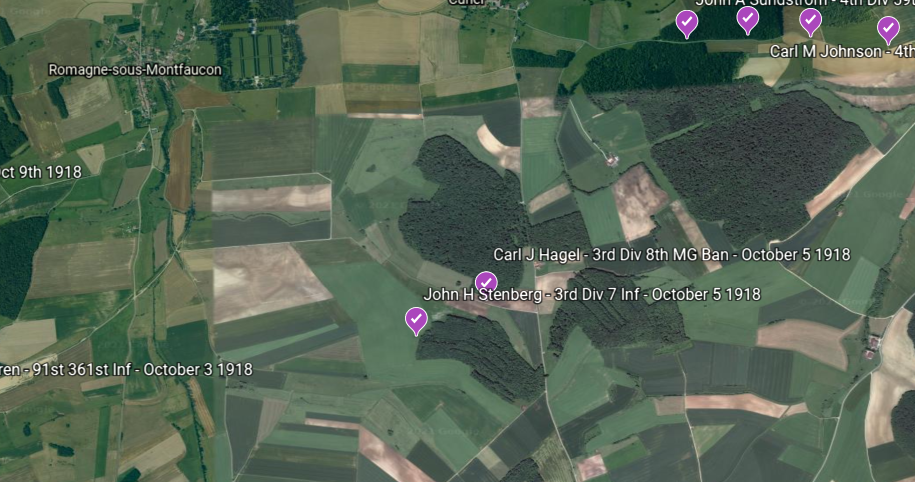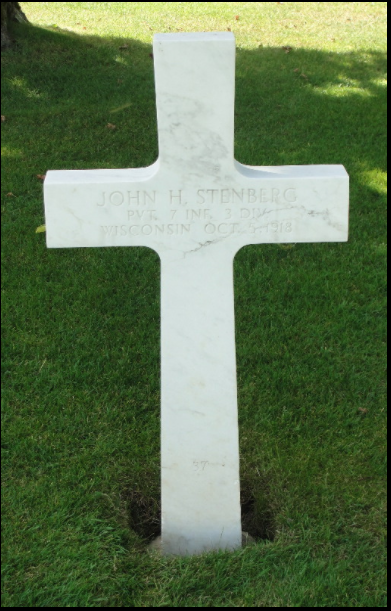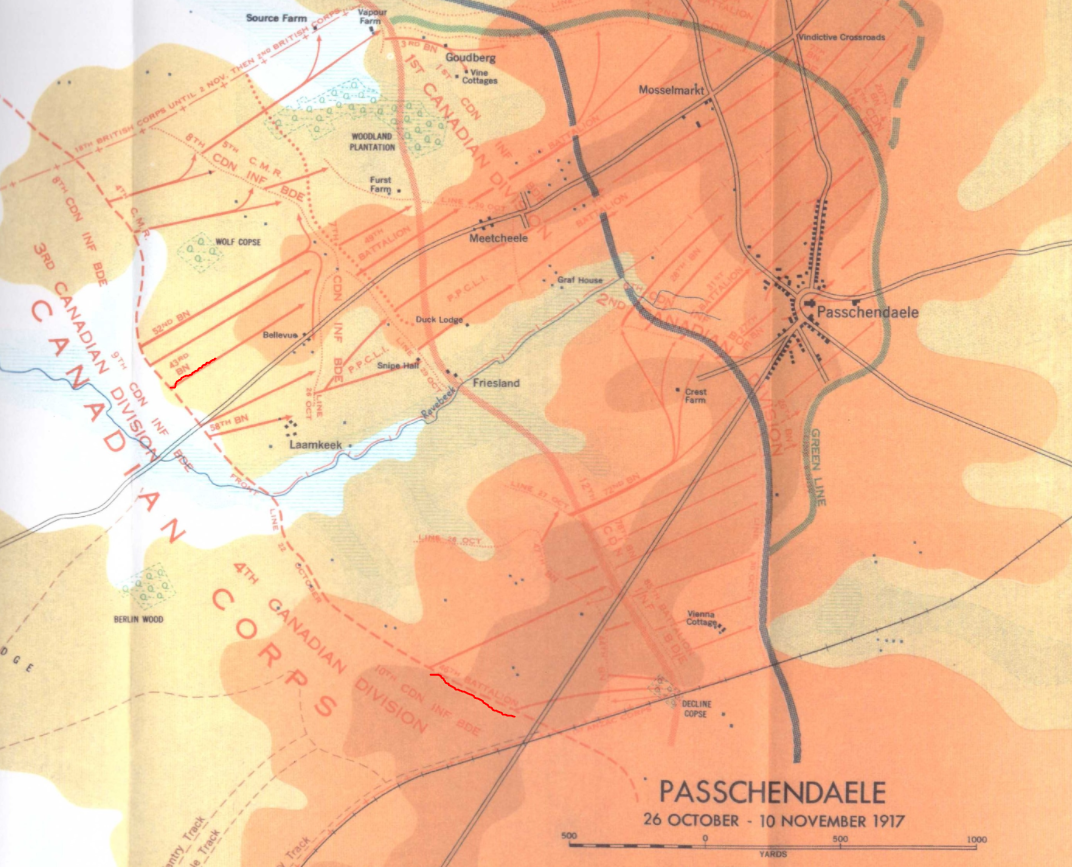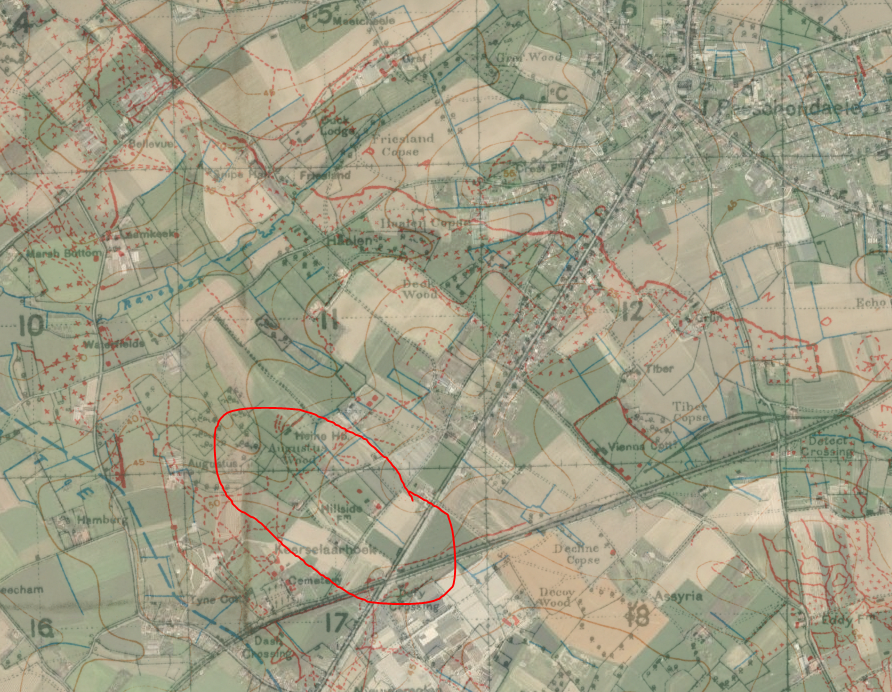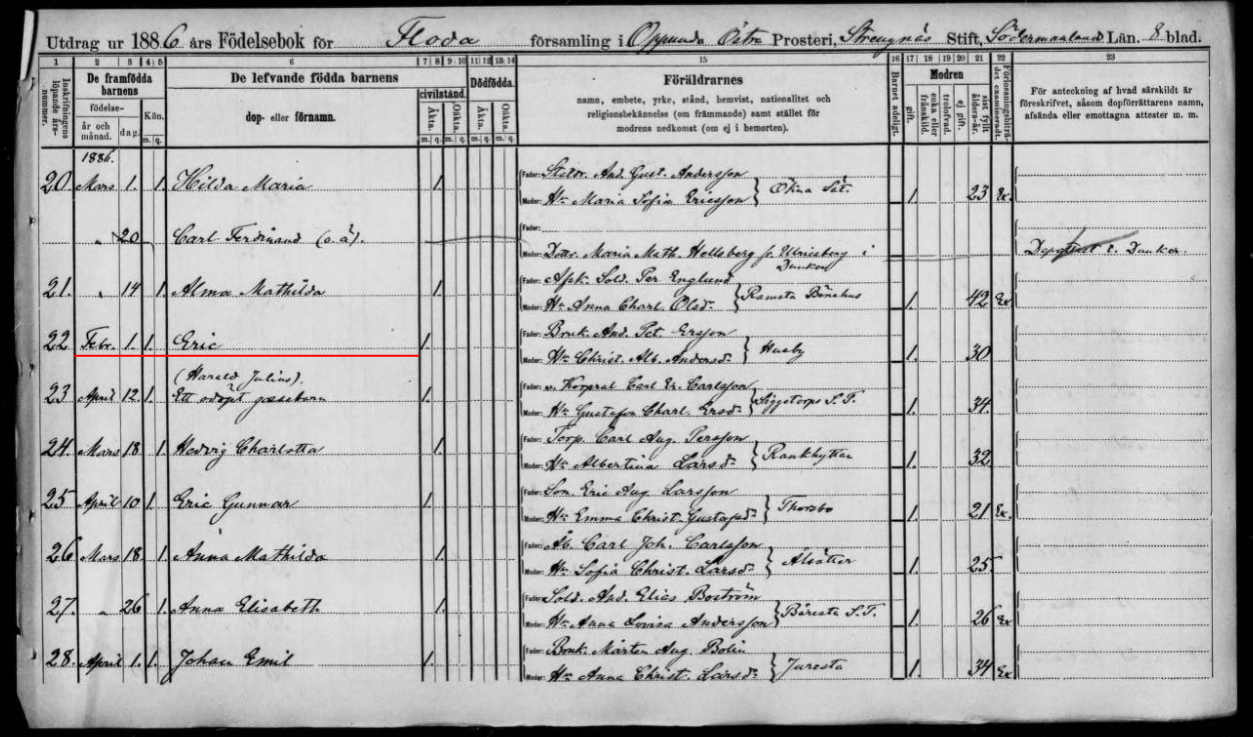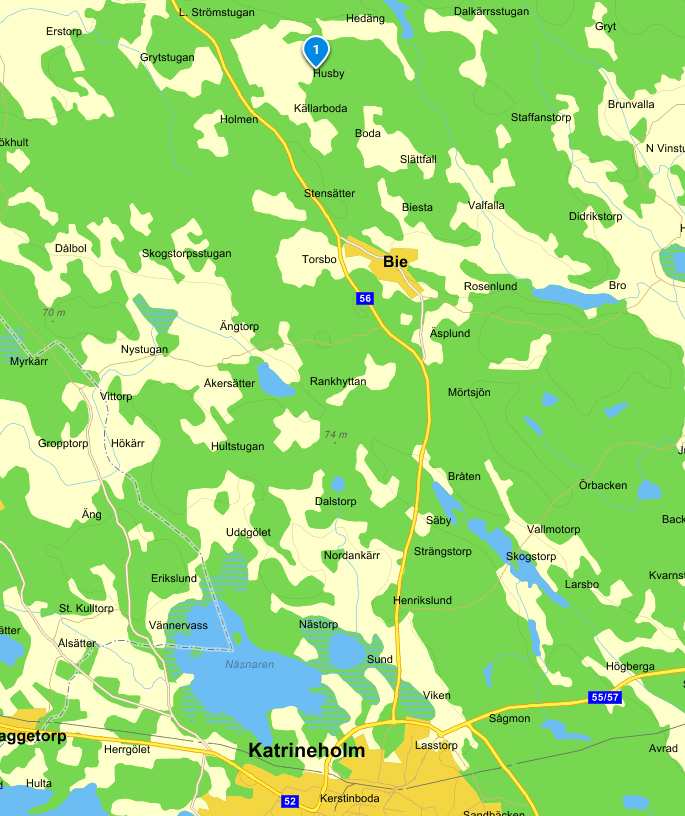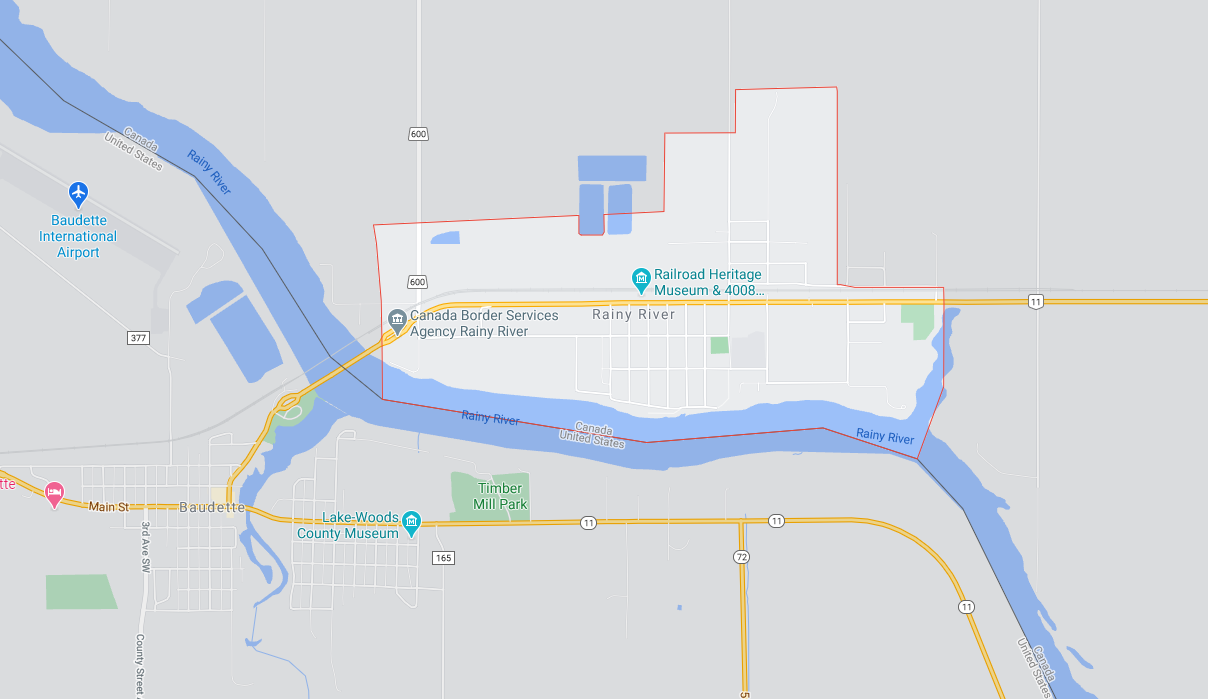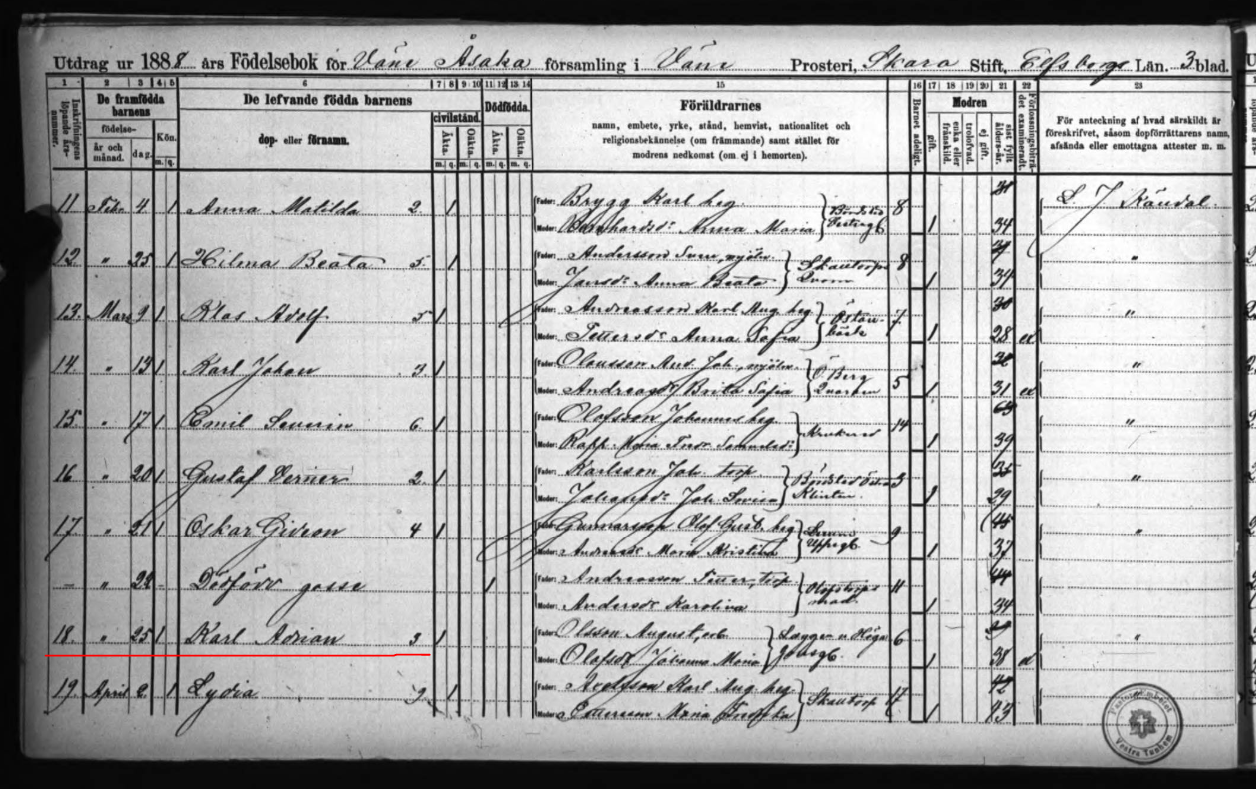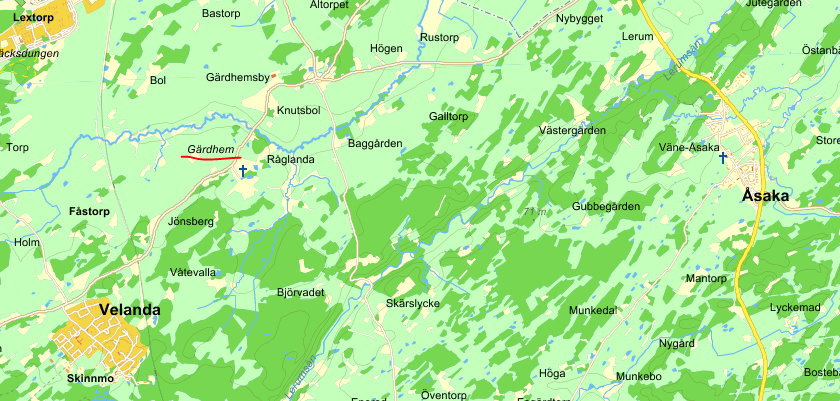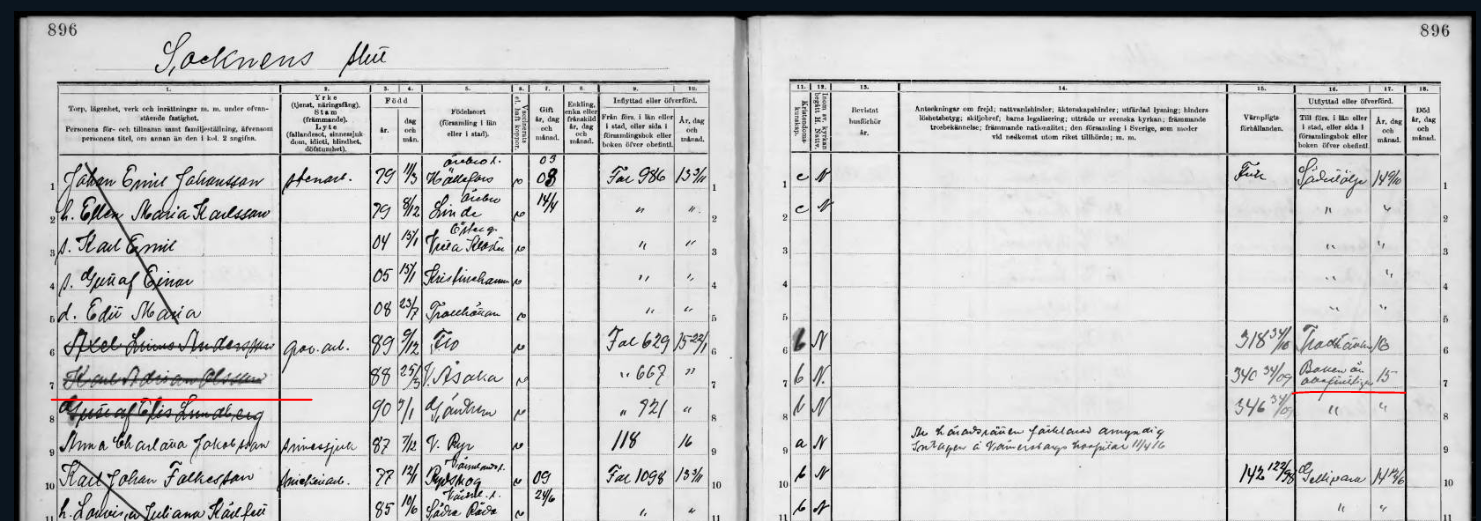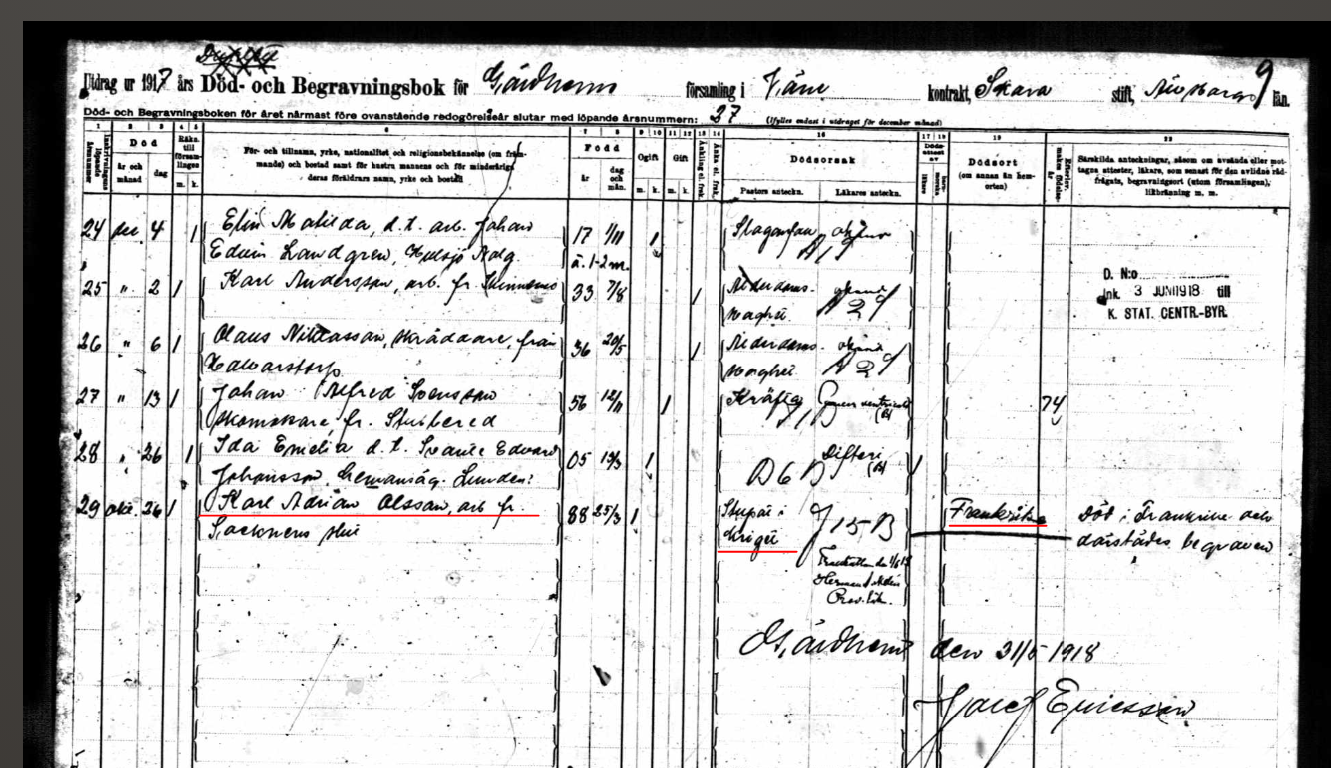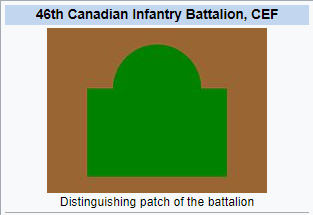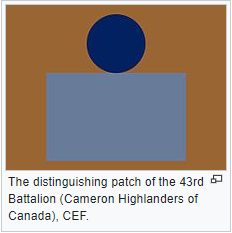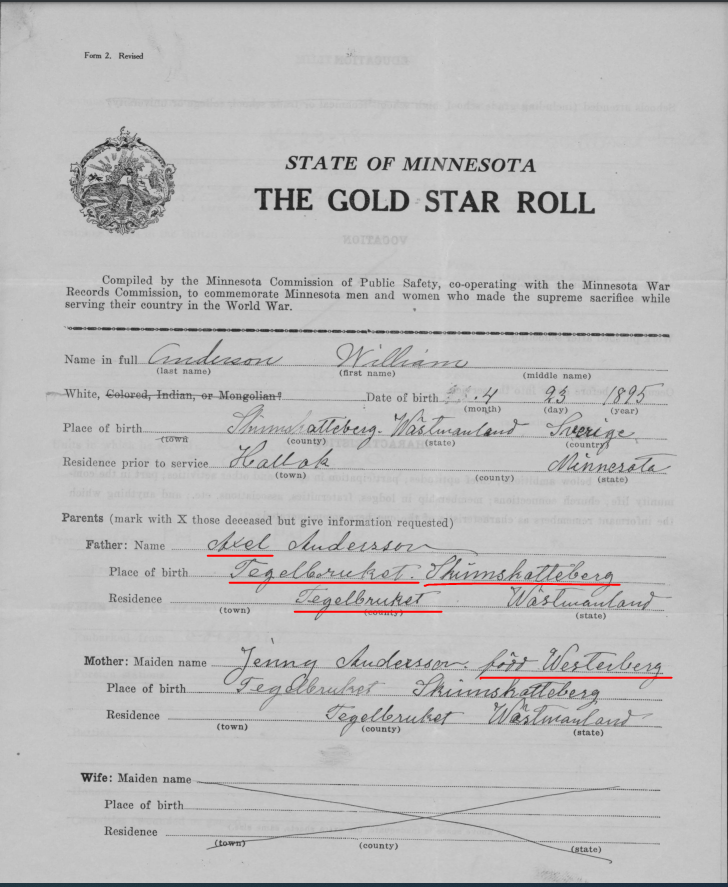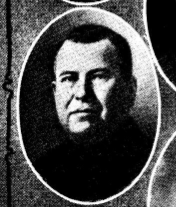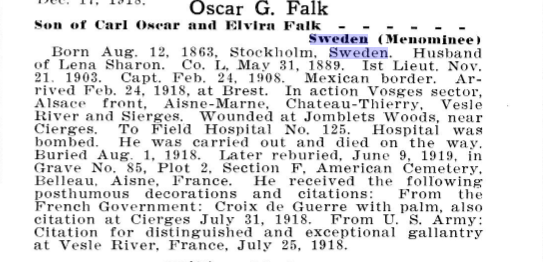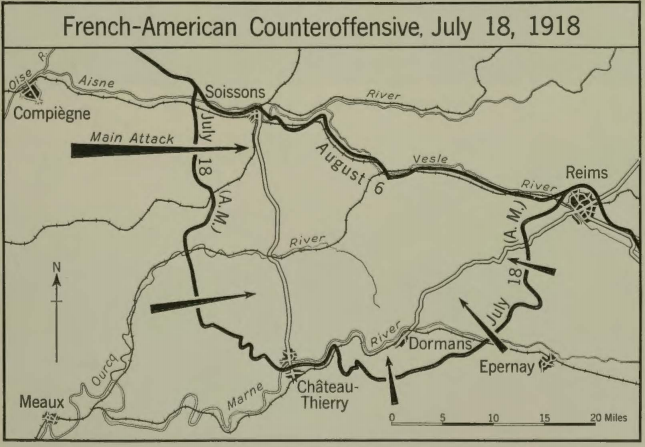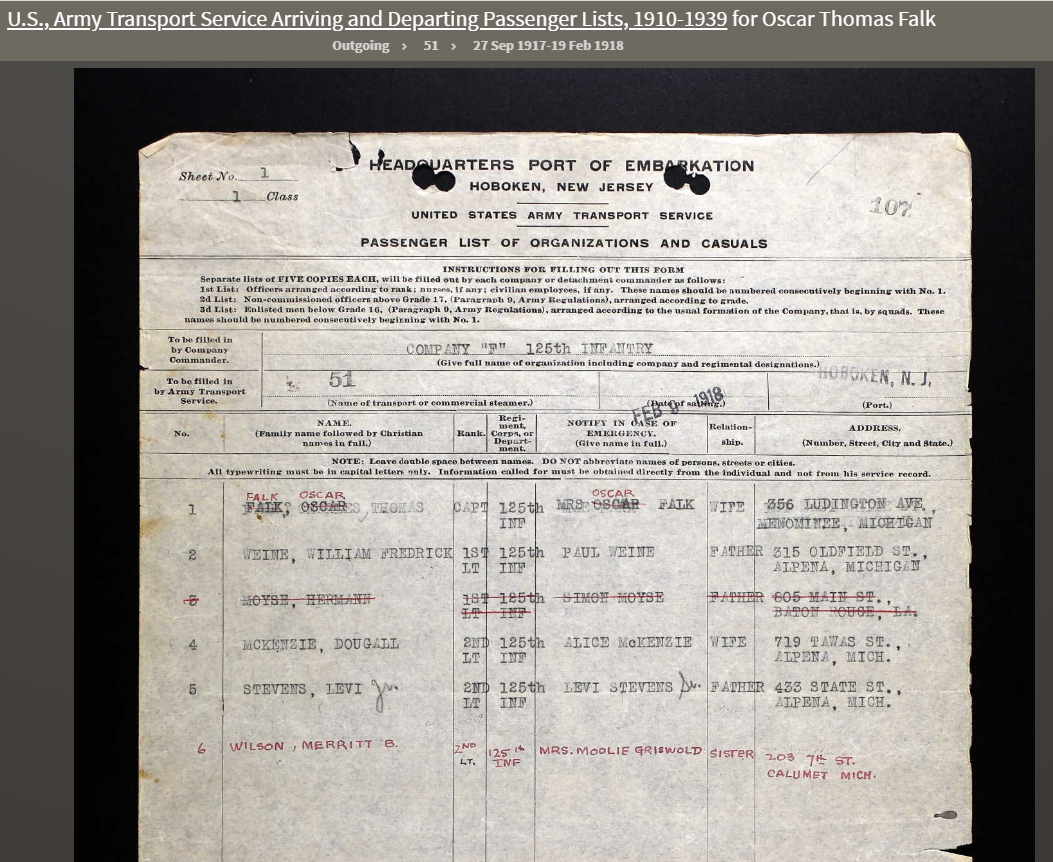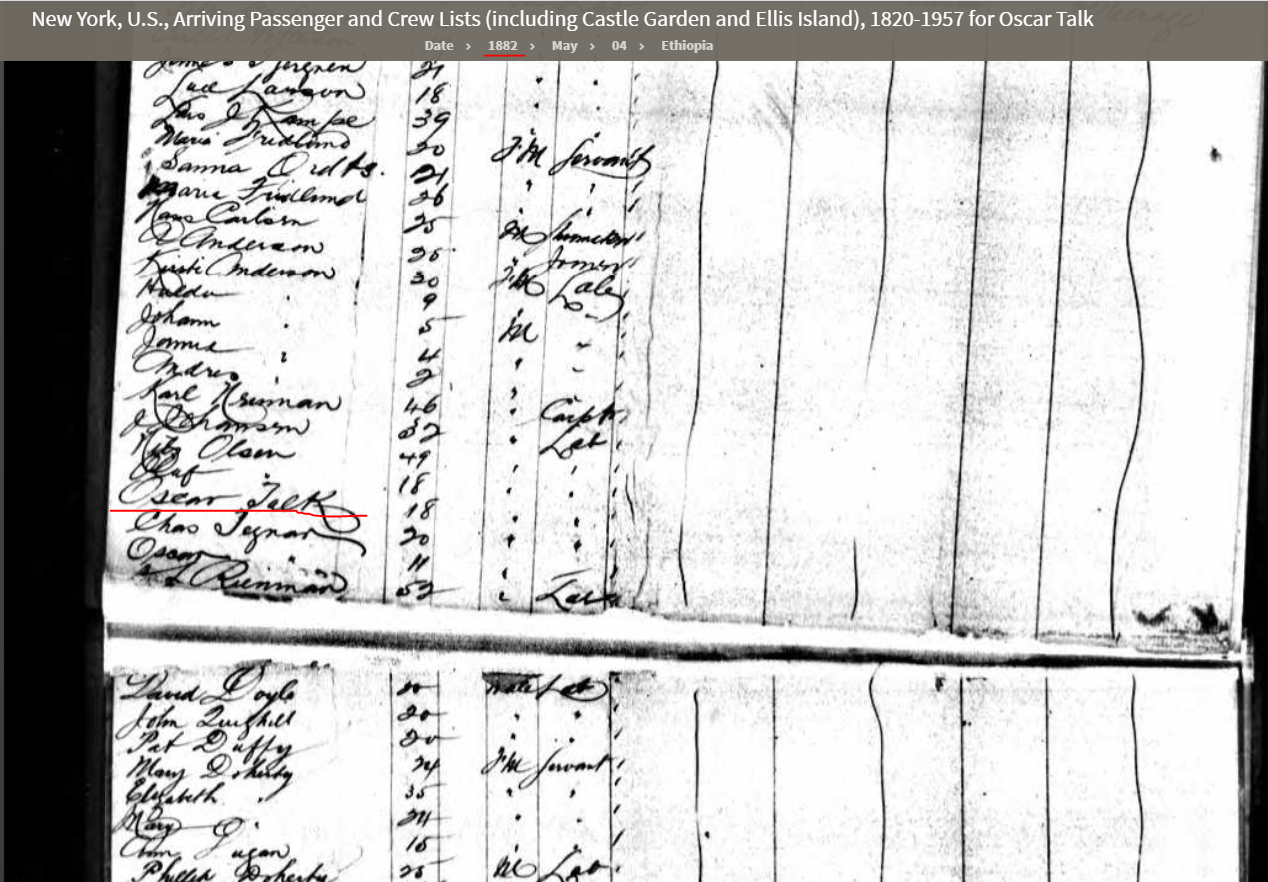I have now updated the soldiers list which you can find in the main menu. At this date, June 7th, 2021, there are for the moment 313 soldiers in the list.
Link in “Svensk Historia”
Just got a message from the Swedish online magazine “Svensk Historia”, Swedish History, that they have put my web page in their link directory! I really appreciate this action, and send my warmest thanks to those who are responsible.
The page are in Swedish though but you can reach the online magazine through this link.
The faith of 1.st Lt John Norman, AEF.
One evening I was working with my research, and was looking for some names with a kind of Scandinavian connection, and just went back to cards that I had overlooked before. I then discovered a casualty card with the name John Norman, 1st Lt in the 165th Infantry, 42nd Division, called “the Rainbow Division”, American Expeditionary Force. (AEF)
The unit spent March 1918 under French command to gain experience about Trench warfare.
According to the card John was killed in action March 7th, 1918, as I though was quite early in the period for the AEF in France. I decide to look it up and found information about a story I havent heard about before. John was killed at an age of 47.
According to some sources John is born in Säffle in Sweden, which is in Värmlands län, in the western part of Sweden, just west of the big lake Värnern. It is told that he is born March 25th, 1870, and I am now trying to find more information that can confirm this, which for the moment is a bit hard. In this case I am looking through church book from that region, but I think Säffle can come from the fact that his brothers adress is Säffle on the casualty card, and that type of information has the tendence to “walk around” and become a fact that may not be connected to the person itself. I am also looking into other dates of birth.
The story about when he lost his life at the Western Front is very sad to read, and as I understand now, it is quite many stories written about this situation. Below you cand find some word from one of the stories. It was the first week at the battlefield for the personnel in the New York National Guard 69th Infantry, called “Fighting sixty-Ninth”, a unit with Irish heritage, the name was given to the unit in the American Civil War, by Robert E Lee.
“At about 3:20 p.m. the enemy launched a barrage of shells in the 2nd Battalion’s position for about an hour,” wrote Richard Demeter in his 2002 history of “The Fighting 69th.” With the majority of troops below ground in hardened dugouts for protection, tragedy struck when a German shell landed on and collapsed the dugout where 1st Lt. John Norman, a regular Army officer and his two dozen Soldiers of 1st Platoon were stationed.
The dugout was some 40 feet below ground, with timbers to protect the Soldiers, and numerous turns down a stairwell to the entrance.
“Tons of earth and stone cascaded,” recalled Pvt. Alf Helmer, a native of Norway and one of the few survivors of the barrage, explained in the 2008 Stephen Harris book “Duffy’s War.”
“I remember only the crash,” Helmer recalled. “Thoughts ceased. I only know that I found myself in the doorway of the forward entrance, hands extended over my head.”
Maj. William Donovan, commander of the regiment’s 1st Battalion, was visiting the 2nd Battalion command post after the relief in place when the barrage struck. Donovan volunteered to make an assessment and assist in the rescue efforts of the imperiled 1st Platoon.
Initial efforts were able to recover seven Soldiers, two alive and five dead. Donovan and a rescue team could still hear other survivors, including Lt. Norman, from the crater of earth and timber.
Not all of the New York Soldiers perished in the initial blast that collapsed the dugout, Helmer would later recall in the Harris book’s account. Half the platoon had survived, but with little space for air and tons of earth and debris, Helmer expected everyone to die as he frantically used his own helmet to scoop away dirt and create space to breath.
“Choking dust and gas stench filled the suffocating darkness,” Helmer’s son recalled for an interview for the Harris book. “I gave myself to prayer and making my peace with God, I was no longer afraid.”
Under intense German artillery fire, including a gas attack, the frantic efforts to dig into the crater and save their fellow Soldiers continued, assisted by the regiment’s engineers of the Pioneer Platoon. Sgt. Abram Blaustein, one of the estimated 60 – 80 Jewish Soldiers serving in the Irish regiment, helped to lead the rescue efforts.
“The Pioneers were called out to try to rescue these men,” recalled Al Ettinger in his account to his son in the 1992 book “A Doughboy with the Fighting 69th.”
“All night long we labored. Two lieutenants have general direction but it was Abe Blaustein who really took charge and led by example. The men worked in relays, but Blaustein always took the most dangerous position,” Ettinger said.
For his heroic actions, Sgt. Blaustein received the French Croix de Guerre and the moniker “Blaustein of the Irish.”
Donovan also received the Croix de Guerre for his actions in leading rescue efforts under fire.
The trauma of the loss and the determination to act even touched the survivors. Pvt. Helmer, once rescued, moved on to the medical aid station and the battalion command post to report on the tragedy. Then, according to Harris in “Duffy’s War,” he requested permission to return to the site to assist with rescue efforts.
“I knew that unless I saw the thing through,” Helmer said, “I would never again be able to look my comrades in the face.”
As rescue efforts the following morning became too dangerous under the German artillery barrage, and no further sounds came from the dugout, it was decided to halt work and leave the remaining 14 Soldiers and 1st Lt. Norman where they were buried. The regiment placed a marker and moved on.”
Text from army.mil.
The story has also been the base for a movie “The Fighting 69th”. A small clip on Youtube here:
I will now try to search further on in the archives, trying to find information that confirms that he is born in Sweden. The confirmation is an important part in my research.
Reached 300 Individuals in the project
During this week I reached 300 Swedish born soldiers who fought and fell at the Western Front in The Great War. I never thought from the beginning that I should find so many, and now when I have so far found these 300 I already know there are more of them, that fits into my criterias for my research.
I will continue to look for more soldiers, and put them into my research. They deserves to be acknowledged.
You can reach the list of all these 300 during the main menu or through this link below:
I have also during the evening updated the Google Earth project about those Swedes who fought in Meuse-Argonne offensive together with the American Expeditionary forces. There are currently 74 Swedes plotted out on that map for the moment.
You will reach the project through the main menu or through this link below:
Have I found them all?
Last evening I was working with my database over those Swedes who were born in Sweden, fought at the Western Front in The Great War, fell at the Western Front and are buried and Commemorated at the Western Front.
I looked over the different archives again, looking for more names, trying to find more soldiers which I dont have in my database, but I have now looked through “all” the facts, and I think to myself; Have I find them all now? Those who fits inot my criterias? I dont know, I will still continue to go over all the facts again, but I have now looked through the US, CAN, AUS, UK, FR and GER archives, and in the database I now have 285 soldiers.
Of those 285 I have confirmed the birth in Sweden for 239 of them. I have developed my tools in looking up the background of those I still havent confirmed, and I will continue with that. When I say confirm, I mean finding the page in the Church book where their birth are noted, so there are little doubt about that they are born in Sweden, but I want to confirm it anyway.
But there are of course more than 285 soldiers who fall into my criterias, but we know that some archives are destroyed, and probably contained more facts about Swedish soldiers who fought in WW1, like for Germany, which is one of the countries that I have very little information from.
But right now the database contain those 285. You find the soldiers list in the main menu above, where you can see the names, where they are buried and also when they were born and died.
The disposition is right now as follows, and this is based on the the soldiers that I have found at the moment. The chart shows in which country armies they fought.
I will during the upcoming days look throug the american files again, and maybe I will reach about 300 before I go into next phase, which means trying to find more information about each soldier.
I really hope I soon can go down to Belgium and France to start to take photos of the different sites, where the soldiers fell and where they are buried and commemorated.
More about Swedes in the AIF
I went back to the Australian archives to search for some more Swedes who fought for the Australian Imperial Forces at the Western Front in The Great War.
Here I will give you some information about one of those individuals, but also bring some light into the different paths I walk when trying to find and confirm the information.
When I search for for information in different archives I try to put in different search strings, and the most common I use at this link below at National Australian Archive (NAA) is “Sweden” or “POB Sweden” (Place of Birth), as I have learned from the texts that is presented in the search results.
Some of the results leading me to individuals who were registrated to AIF, but I also get other information connected to Sweden, not all leads to soldiers. Sometimes the other information can be interesting to though.
When finding an individual there is the amount of information who takes me further. Like in this example. I found the Individual Neil Nilsson, and the first page gives me som leads that this in an individual from Sweden. Place of birth and Next of Kin (NOK) can be good info to go further on with. In this picture below you can find some underlined text. One odd thing is that in these papers they only ask for age, not Date of Birth (DOB)
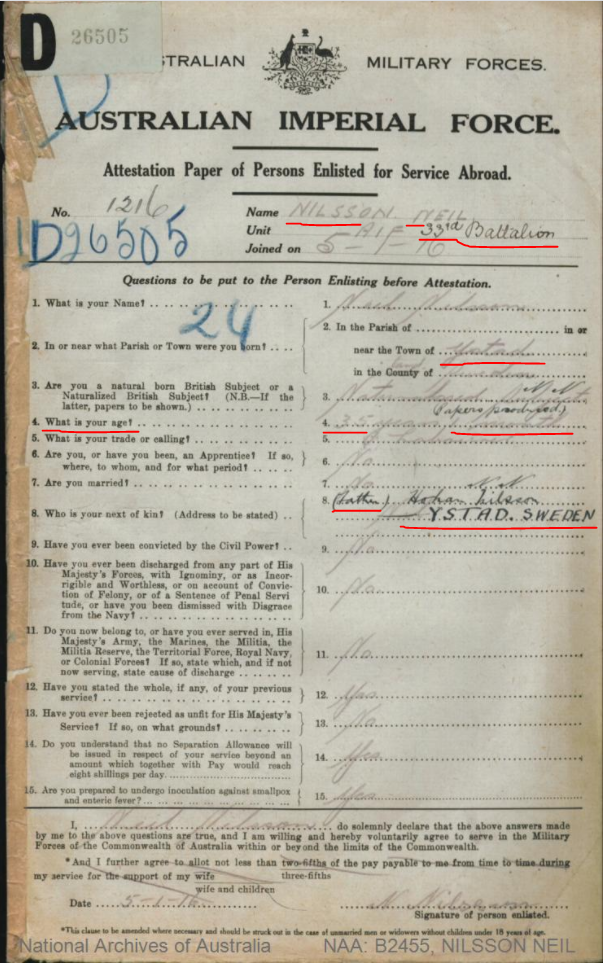
From this page I take with me:
- Nilsson, Neil, (probably Nils, I will check this later)
- 33rd battalion. This is his first unit, but they can also switch during their time in the Army and on the field)
- Age 35 and 1 month, compared to the date they are registered above, then I get a clue of DOB. He became 35 in November or December in 1915, that could then mean born in 1880? In this case it did. But many times they just guess or dont know exactly, depending on when they emigrated.
- Ystad. He lived there or was born there, but that can mean everything around Ystad, but works as a starting clue.
- Father. Hohan? Johan? or Håkan? It turned out to be Håkan.
Before I take the above info with me for further search in other archives, I use to check the additional info, which is a lot. In This case I check if he fought on the Western Front in WW1 and if he survived or if he was killed. In this case he fought on the Western Front and fell near Ypres in Belgium. But how do I know that? We have to take the info we find further into other sources. Below some of the info that I get from the case of Neil. Luckily the info written with pencils are often later typed as well, or it can be hard to read sometimes. My skills are increasing for every time.
But first we have to check and connect Neil Nilsson to Sweden and Ystad, and also in a way try to see if 1880 is a correct conclusion. I use a service that I pay for in this case, the archives at Ancestry. Here it is very important not to “take corners” and assume that his name is Nils, we have to use the name he has stated, to find info connected to this. Below some results from Ancestry that takes me further.
We know the name Neil Nilsson and that he died June 8th, 1917 according to the papers above, and I also try to type in 1880, just to see what happens. I get the same info from Ancestry as I already know, and it also shows the name of the father is Hokan, and here in Sweden it is Håkan, and it also shows that he is commemorated at Menin Gate memorial, which gives that he has no known grave. I have to search more in other archives, to try to find his DOB and I am lucky! I use the same search engine, the NAA, and gets the Naturilazation papers which gives me his DOB. Perfect. That makes my search more narrow.
Adding November 5th 1880 to my facts, and goes to my other source, Arkiv Digital, a quite expensive archive service, but gives me almost everything I want to know so right now it is worth it. In this Swedish archive I search for Nils, not with Nilsson, for the reason that the kids are stated in the books with just their names, not surnames, which comes later. We also know November 5, 1880 and Ystad.
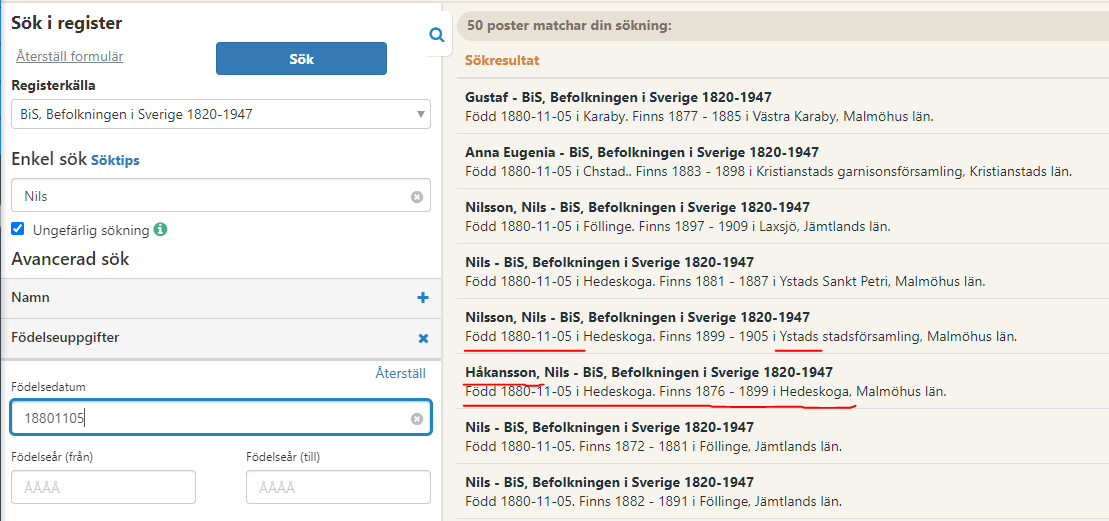
I get a few leads. I know that his father is named Håkan, and in Sweden kids sometimes gets their surnames from their father, so this is a lead. I also get Hedeskoga, the Perish where he is born. I use Hedeskoga in a new search in the same archive.
That gives me a lot more to look through. And in the results I find what I am looking for. This is the right person. It is hard to see in the picture, but the text states that papers from some officer in the British Army gives information about Nils death. In the margin the date of his death is stated. June 8th, 1917.
I also see that they have written his full name, Håkansson, Nils Nilsson. I decide to try to put that into Ancestry again, and here I find more information about his death, even if they here writes that he was killed in France, not Belgium. I can see the word “Messines” in the notes and we will check further into that.
Where were Nils unit when he was killed in June 8th 1917? We will look for the diary in some Australian archives. The archive I use for that is Australian Imperial Force Unit War Diaries. It turns out that his unit, 33rd battalion took part in the large offensive, the battle of Messines Ridge, which was at that time a success for the British Expeditionary Forces, in the attempt to flatten out a kind of a bulge in the front just south of Ypres, Belgium. The diary states that Nillson was killed in action in the battle, we find his name in one page in the 144 pages long diary. (Yes, I looked through all the pages) The 33rd Infantry battalion most likely fought within Second ANZAC Corps in the southern part.
If you want to find out more about The Battle of Messines Ridge, you can start at Wikipedia. You will find a lot of information.
We know that Nils today are commemorated at the large WW1 memorial in Ypres, Menin Gate Memorial, for the reason that he has no known grave, but can we find out more what happened to him? Yes we can. We will take a look in one other Australian Archive, Australian Red Cross Wounded amd Missing Files. From erlier we know his name and regimental number. I use his regimental number 1216 in the search for more info, and I get a hit. The name is correct, Neil Nilsson, number 1216.
It turns out that this archive contains more information about where he was buried right after where he fell. Probably that place is since long gone, due to that the war continued, but who knows? Maybe he one day he will turn up in any excursion, at the place he was buried. Below you can see some statements from his comrades.
I will continue to search for those Swedes who fought at the Western Front, and it is very exiting to follow the destiny of those Swedish born individuals that in the end gave their lives in the fightings in The Great War. May they rest in peace.
Archive find gave another three soldiers
Last week I was at “Utvandrarnas hus” in the town of Växjö, around 1,5 h car trip from my home. Mu intentions were to look at some archive finds after had been talking to the manager in the phone the day before.
The personnel were very helpful, and helped me with the things that they could find. From the beginning I sent in some names to the archive, but they couldnt find any things connected to the name I sent in, but they found three other names that I did not have in my list.
One of these three soldiers was Ernst A Petersen, named Ernst Albin Petersson in Sweden, born in November 1890 in Urshults perish in Kronoberg county, in southern part of Sweden. Ernst went to North America in march 1909, aged 18. Joined the American Expeditionary Force from Minnesota in 1918, and left for France and the Western Front in August 1918.
He fought for 128th Regt, 32nd Division in the Meuse-Argonne offensive. Ernst died of wounds received in action October 13th, 1918, and he is buried at the American Meuse-Argonne cemetery.
The second soldier was Nels G Swanson, in Sweden named as Nils Gottfrid Svensson, born November 1918 in Reftele perish, Jönköpings county, in thye southern part of Sweden. He left for USA in 1906, age 18, and joined the American Expeditionary Force from the state of Washington. He fought for 11th coy, 20th Engineers in the Meuse-Argonne offensive, and he died from wounds received in action October 11th 1918 and is buried at the American Meuse-Argonne cemetery.
The last of those three individuals I found through the local archive was Louis Munson, named Ludvig Månsson in Sweden. Ludvig was born in Karlskrona Amiralitets Perish, Blekinge county in the southern part of Sweden. He left Sweden from Stockholm in 1913 for North America, and probably went over to France in summer 1918, as many other soldiers connected to American Expeditionary Force.
Ludvig fought for 353 Infantry Regt, 89th Division, and are noted to be missing in action sice November 4th, 1918. In November 4th the second part of the Meuse-Argonne Offensive started, ant the battles are known to have been heavy in the region. Ludvig is noted on the walls, as he do not have an own grave, at the American Meuse-Argonne Cemetery in France.
I will continue to search for more individuals connected to the local archives, and even if I sometimes think that I have found most of them, those Swedish soldiers who fought and fell at the Western Front in World War 1, I am pretty sure others will occur in the archives.
They are there, somewhere. May they rest in peace.
Digital research – Yet another small story
It is not easy, and you really have to be determined sometimes when looking for facts in the different archives.
As you know I search for my Swedish soldiers in the different archives out there, both the large and common ones, but also in the outskirts of the normal digital resources. I was searching for some swedish names in Wisconsin Gold Star list, a kind of a Honor Roll that I found through Familysearch portal. I started to search by putting the word “Sweden” in the search bar, and got three hits.
I find Swan O Peterson, stated to be born in Sweden, and I cross check with the American archive over casualty cards, and he is there, but he is buried back home in the states, and then he is outside my criterias for my project, as I search for those who are buried at the Western Front. But under him I see another name that looks Swedish, but after that person, it does not say “Sweden” but I decide to check him up.
I know that I have searched through his casualty card before, but then I did not see that is actually says that his next of kin is from Sweden, his father is from “Holma, Medange, Holm”. – that can be anywhere, I think for myself, but I decide to search for John H Stenberg in Ancestry. I find a John H Stenberg and it says that he is born February 1st 1890 in Boltak, Skbg.
For many people this could be quite hard to read, but luckily I have passed the sign everyday for three years on my way to work, and I know it means “Baltak, Skaraborg”. Baltak is a small village in Skaraborg region. So far so good, he is born in Sweden, but is this the correct John?
I search in a map for Baltak, and I see quite quick some familiar villages around Baltak. I see Madängsholm, and look at Johns fathers place again, ah, “Medange, Holm” should be Madängsholm. This is probably the correct John.
The next step is to search for him in the Swedish Archive “Riksarkivet”, and the name I know is John, and we also know that it can be Johan, and I try to search for “Johan H*”, and also put in the year 1890 as we know from Ancestry. I get 223 hits.
I know that Baltak is in Västra Götalands County, and in the area of Tidaholm, and that narrows it down to 3. And there he is, Johan Harry, the fathers name is Stenberg. Here he probably is. But I want to look in the church book as well and then I have to search for the perish that Johan Harry is born, which I find from the first search. The perish of Agnetorp. And there he is. Born February 1st 1890. But the name says Jan Harry…
From the beginning we had John, that I guessed could be Johan, and now he is baptised to Jan, or could it just be written wrong?
I decide to search for Jan Harry as well, but I do not find anything, and decide to search for John Harry, and I actually find him again under that name in the same archive, with some of his family as it looks like. This is not easy at all sometimes. Ok, I am quite sure that this is the individual I am looking for.
I now want to take a look in the other chapters in the church book, and when I do that I find the family, and he is the book as well. I have to know that they lived in “Brunnsvik” which I found in the earlier search, just to be able to find the right page in the book instead of searching through all the pages, that sometimes can be around 1000 pages. It says that his father left for America in 1905, but I can see some notes about that he maybe came back. John moved to another village nearby, which I think was Velinga, in 1904, and I know that village is nearby, also from my commute to work … I also see in the church book that there is a line over “A” in “Johan”, so maybe the correct name was John all the time after all?
I also find that John left Sweden for USA in April 23, 1913, from the notes in the list from the ship that he left with. I dont know when or where he settled down, but I know he joined the AEF from Wisconsin, and went to France after have joined Co L, 7th Inf Regt, 3rd Division, and that he fought in the Meuse Argonne offensive and fell just south of the village Romagne in the Argonne region in October 5th, 1918. John is buried in the Meuse-Argonne American Cemetery.
I see that John belonged to the same Division as Carl J Hagel, another Swede from Skaraborgs Region, village of Essunga, not very far from Baltak, so this gives me some new to dig in to. May both of those Swedes rest in peace.
Swedes at Menin Gate – The story of Erick Anderson and Karl Olson – October 26, 1917
[Remarks: My normal language is Swedish, so please feel free to comment if you find some information in english is expressed in a strange way]
October 26 1917, the start of the second Battle of Passchendaele within the Third battle of Ypres. It was the second part of the Battle of Passchendaele (Dritte Flandernslacht [GER], Troisième Bataille des Flandres [FR]) that took place between July and November in 1917.
I will in this post tell you more about two of the so far 16 Swedish soldiers that are commemorated at the Menin Gate Memorial in Ypres in Belgium. So far I have found 16 Swedish born soldiers at that memorial, which are soldiers with no known grave, and they are commemorated together with almost 55.000 other soldiers in this monument. May they rest in peace.
Erick Anderson and Karl Olson were killed in action the same day, fighting for two different Canadian units but they were not far away from eachother this specific day.
Erick Anderson was born as Eric Ersson February 1st 1886. His parents were Kristina Albertina Andersdotter and Anders Petter Ersson, Erick probably took his surname after his father Anders first name, which was a common method at that time.
There is no information about when Erick left Sweden but there are some documents that states his census for Canada in 1906 as a Lodger. This is not confirmed. He is registered for the Canadian Army February 28, 1916 at the age of 30, and on the same card it says he is living in Rainy Rivers, Ontario, Canada, right on the border to the USA. Many Swedes went for Canada in these years, and Ontario was a common place to settle down.
His next of Kin (NOK) i the papers is his brother Carl which lives a bit south of Erick, in Gonvick, Clearance County, Minnesota, USA. Maybe they left Sweden together. It is quite normal that they stated their parents as next of Kin in the papers, and if the address was to an address in Sweden you can assume that the parents still lived there, and that the Swedes who went over, did that by themselves. If someone have siblings as NOK they probably emigrated together or just after. In this case I cant find any other address for Ericks parents in the Swedish Archives.
Erick arrived in England from Canada July 6th, 1916 and is Taken on Strenght (TOS) to the 5th Canadian Infantry Battalion. According to thye Casualty card he is injured in his right arm by a shrapnel or a Gun Shot which penetrated his arm. He received this injury in the battle of Vimy Ridge in France, April 11th 1917. He was at that time fighting for the same battalion as another Swede, Axel Renyus Carlson, who you can find in my soldier list in the Main menu in this web page. Axel was killed in action in that battle.
In my list I have 7 Swedes who fought for the 5th Canadian Infantry Batallion, and they will later on have a story for themselves.
Erick was discharged from Wharncliffe War Hospital in Sheffield June 11th 1917, and then later became attached to 46th Canadian Infantry Battalion in September 26, 1917. In October 26, 1917 he is reported to be wounded and missing, and later on reported to have been killed in action the same day. Erick has no known grave and is therefor commemorated at Menin Gate Memorial. When reading about the Battle of Passchendaele you understand why many soldiers dont have their own grave, They could have been buried where they fell, but the grave could probably not be located after extreme shellings later in the battle.
The same day Karl Olson participated in the same battle but in another battalion. Here is the story about him
Karl Olson, or Karl Adrian Olsson which was his Swedish name, was born in Åsaka Perish in Älvsborgs County, Sweden, March 25, 1888. His parents were August Olsson and Johanna Maria Olofsdotter.
According to the church books he went to North America in 1915. Before he went over he did his conscript period in Swedish Army, as every 21 year old man did at that time. Right now there is no information how Karl went over to the USA but the paper states that he was registrated for the Canadian Army January 8, 1916.
He left Halifax, Nova Scotia December 15, 1916 and disembarked in Liverpool December 28, 1916. He landed in France and was taken on strenght (TOS) for the 43rd Canadian Infantry battalion was may 4th, 1917. There are not many events stated in the Casualty Card before he is killed in action October 26, 1917, first day of the second battle of Passchendaele.
The church book mention he is killed in France but we know now he was killed in Belgium. In the diary for the 46th canadian Infantry Battalion you can read the text by Captain Galt:
“The situation looks OK as far as I can Judge. The 52nd are 100 yards in front of us and in fair strength. It is to be regretted we did not get further, but it was not possible. S.O.S is in working order and conditions considered we are OK.”
The casualties for that first day for the battalion are estimated to be 13 officers and about 300 ORs (Other Ranks)
Karl Olson has no known grave, and he is also to be found on the Menin Gate Memorial in Ypres, Belgium.
We will never know if they met eachother in any situation in Canada or in the battlefield, but they did what they could for their new country, and will be remembered through this project. You can also read more about the soldiers and see thier locations where they are assumed to have fallen in my project by the link “Virtual Tour on Map” in the main menu.
These are the first stories about Swedish born soldiers who are commemorated at the Menin Gate, more stories will follow.
One goal is reached – heading for the next
Today I found the two last posts in my list which makes it contain 200 Swedish born soldiers who fought and fell at the western front. The two last individuals are Axel T Rydell (Axel Tolli Rydell) and William Anderson (Axel Wilhelm Andersson-Westerberg). William is number 200 in my list and also some kind of symbol of that, as he was Killed in Action November 11th 1918, the day of the armistice for World War One.
There are probably more soldiers out there who will fit my criterias that I have specified in my project, but these 200 will now be more developed, and in the end they will be menitioned in my future book about those soldiers who went from Sweden and joined their new armies and fought for them at the Western Front in The Great War. I will of course put the others in my list but they I will keep for later work.
I will also give you an example of those Swedes who went over to another contingent, fought in the Great War at the Western Front, but are buried in their new countries.
One of those is Oscar G Falk, who was born with the name Germund Oscar Falk. He is also mentioned as Oscar Thomas Falk in some cards, and his sister Elvira is mentioned as his mother. I understand this as the information at that time was quite hard to check and confirm.
Oscar was born August 12 1863 in Brännkyrka Perish, Årstadal, in Stockholm, Sweden. (The same perish I was baptized in). He went to USA at the age of 18, in 1882, he should be 19 later that year, and he settled down in Menominee, Michigan, USA.
He became 1st Lieutenant November 21st 1903 and later on became Captain in February 24th 1908. As the text in the Honor Roll states he went over to brest in France in 1918 and fought in the Aisne-Marne battle in July 1918 and became wounded and taken to Hospital. The Hospital became bombed by the Germans, the personnel managed to take him out but he died August 1 st 1918.
After his death he received decorations for his exceptional gallantry in fightings around the river Vesle in France. He received the French Croix De Guerre, The French War Cross. Dont forget that he did this in the age of 55. Amazing. The information states that he was reburied June 9th 1918 in the American Cemetery in Belleau, Aisne in France. The Casualty card states that his body is recovered and moved to USA and buried in Riverside Cemetery in Menominee, Michigan.
I will now continue to find more facts about the 200 individuals I have in my list, to make the history of all those more deep, connect their different faiths, and later on visit the places where they fell and are buried or commemorated.
Feel free to join me me on my journey forward.



